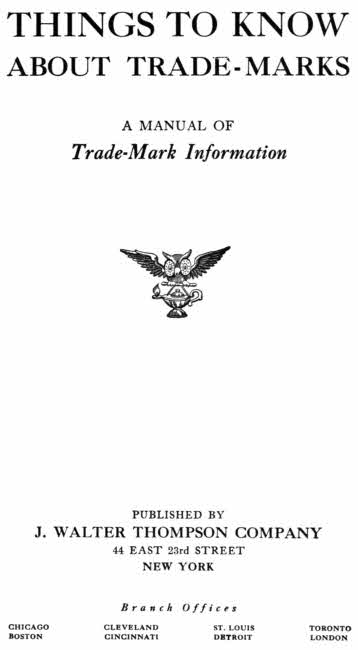
Project Gutenberg's Things to Know About Trade-Marks, by J. Walter Thompson
This eBook is for the use of anyone anywhere in the United States and most
other parts of the world at no cost and with almost no restrictions
whatsoever. You may copy it, give it away or re-use it under the terms of
the Project Gutenberg License included with this eBook or online at
www.gutenberg.org. If you are not located in the United States, you'll have
to check the laws of the country where you are located before using this ebook.
Title: Things to Know About Trade-Marks
A Manual of Trade-Mark Information
Author: J. Walter Thompson
Release Date: May 21, 2015 [EBook #49016]
Language: English
Character set encoding: ISO-8859-1
*** START OF THIS PROJECT GUTENBERG EBOOK THINGS TO KNOW ABOUT TRADE-MARKS ***
Produced by Chris Curnow, Craig Kirkwood, and the Online
Distributed Proofreading Team at http://www.pgdp.net (This
file was produced from images generously made available
by The Internet Archive.)

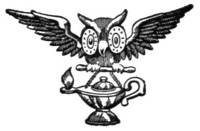
PUBLISHED BY
J. WALTER THOMPSON COMPANY
44 EAST 23rd STREET
NEW YORK
Branch Offices
CHICAGO
BOSTON
CLEVELAND
CINCINNATI
ST. LOUIS
DETROIT
TORONTO
LONDON
Copyright, 1911
By J. WALTER THOMPSON COMPANY

Our idea, in preparing this little book, is to set forth, in clear and simple language, the main features of the law relating to trade-marks and to illustrate its application by specific examples of well-known trade-marks now in use.
To an advertiser who has had but little experience in registering trade-marks, the law, with a congested mass of precedents surrounding it, seems to be a legal maze.
But its intricacy is more apparent than real. The law is quite clear and explicit when one has the patience and experience in such matters to get to the bottom of it. We have endeavored to write this book in language so clear that any business man will understand it, and we feel sure that it will give any one a good working knowledge of trade-mark requirements.
It has not been our intention to produce an exhaustive treatise on the subject. Such a treatment of the law of trade-marks and its allied subject of unfair trade would require a large volume, and the long and intricate discussion of minor points necessary in a work of that kind would be wearisome and perhaps unintelligible to the lay reader.
Nor have we discussed the origin of the custom of identifying merchandise by trade-marks. This phase of the subject—trade-marks in their historical aspect—is interesting in an academic sense, but it has little or no bearing on the trade-mark situation of to-day.
For further study of the trade-mark law and the allied subject of the law of unfair trade, we advise the reading of[4] Hesseltine's "Law of Trade-Marks and Unfair Trade" (Little, Brown & Co., 1906); and Nims on "Unfair Business Competition" (Baker, Voorhis & Co.). Both of these works are legal in their treatment of the subject and in their phraseology. Another work containing much information on this subject is Clowry Chapman's "Law of Advertising and Sales", in two volumes, published by the author.
J. Walter Thompson Company

President.
| Chapter | Page | |
| Introduction | 7 | |
| I. | Digest of The Trade-Mark Law | 13 |
| Property in Trade-Mark Rests Upon Common Law | 13 | |
| Conditions of Registration | 14 | |
| Ten-Years Clause | 16 | |
| How to Apply for Registration | 17 | |
| Procedure of the Patent Office | 20 | |
| Registration in Foreign Countries | 23 | |
| Classification of Merchandise | 23 | |
| State Trade-Mark Laws | 25 | |
| II. | Essentials of a Valid Trade-Mark | 26 |
| Portrait of a Living Individual—When it may be Registered | 27 | |
| Trade-Mark Must not be Descriptive | 28 | |
| Trade-Mark Must not Misrepresent | 31 | |
| Trade-Mark Must not Resemble Previously Registered Mark for Same Class of Merchandise | 32 | |
| A Geographical Name is not Registrable | 34 | |
| Trade-Mark Must not Contain Red Cross Insignia | 36 | |
| Restrictions as to Registering Names | 37 | |
| Trade-Mark Must not be Fraternal Society Emblem | 39 | |
| [6] | Trade-Mark Must not Consist of Flag or Coat-of-Arms | 40 |
| A Form, Color, a Shape, or a Material Not Registrable | 40 | |
| Trade-Mark Must not be Against Public Policy | 42 | |
| Affixation | 43 | |
| III. | Advertising Characters | 45 |
| IV. | Infringement | 52 |
| V. | Assignment | 69 |
| VI. | Trade-Marks in Canada | 73 |
| VII. | How to Devise a Trade-Mark | 76 |
If you were to ask any dozen men among your acquaintances, or any hundred men, to name the greatest writer that has ever lived, the odds are perhaps as great as a hundred to one that every man would say "Shakespeare."
This virtual unanimity of opinion would not have its origin in a conscious comparison of authors and their works, for we might as well be frank with each other and admit that not more than one of us in a thousand has ever read enough of Shakespeare to form any opinion that would be worth listening to.
We take Shakespeare on faith.
We have been taught that Shakespeare was a transcendent genius, the greatest man that ever put pen to paper, and we believe it.
Shakespeare is in evidence on every hand. We quote him every day. He is well advertised. And, needless to say, his reputation as a writer is far greater to-day than when he lived over a wig-maker's shop in London, or even when his fortune had been made, and he had retired with his jig-saw coat-of-arms to the "lordly mansion" on the hill back of Stratford.
He has been advertised for three centuries with praise originating from a thousand sources, and his reputation is now steeped head and ears in Cumulative Results.
Shakespeare's name has become a sort of trade-mark of good literature. If a meddling antiquarian should thoughtlessly add to the afflictions of the intellectual life by unearthing a doggerel sonnet of Thomas the Rhymer to which some clerkly scribe had affixed, in error, the name of William Shakespeare, learned men would read it, and nodding wisely, would doubtless say, "Pretty good stuff"—or the scholarly equivalent of that phrase.
The force of recognized distinction is tremendous, not only in literature, but in business, in science—in short, it is[8] one of the most valuable assets in every field of human endeavor.
A commodity may attain a height of distinction, in the public's estimation, that places it, among other commodities of its class, on the level attained by Shakespeare in literature.
Apollinaris among table waters; Heinz "57" among pickles; Hartshorn rollers among window shade appliances; Coca-Cola among soda fountain drinks; Huyler's among candies; Uneeda Biscuit among soda crackers; Horlick's among malted milks—each of these products has become, by reason of advertising combined with intrinsic merit, the standard of quality in its own class.
It is interesting and easy to make practical tests to ascertain what advertised commodities have made a genuine and far-reaching impression on the buying public.
Take talcum powder, for example.
Ask your wife, daughter, sister, stenographer—and as many other women as are necessary to strike a general average—to write down the name of what each of them considers the standard talcum powder. Then, when all the returns are in, figure up the result. There are hundreds of brands of talcum powder sold in the United States; but you will find in your canvass that only three or four are mentioned at all, and that one of them leads all the rest by a decisive majority. We could tell you what the figures produced by your experiment would show the leading brand to be, but a modest reserve in self-assertion forbids us to say more than that its name begins with the letter M.
The enviable position of this particular talcum powder is the sum total of many years' advertising and trade-mark publicity. It has become a permanent feature of our commercial life; a sort of Bunker Hill in the history of advertising. The natural result is that its trade-mark is enormously valuable.
Advertising capitalizes human faith, and faith is a mental impression. It is a quality of the human mind that the most profound impressions are made by things—not by abstract ideas. Consequently, successful advertising must be tied hard and fast to a name (or trade-mark) and this trade-mark must be distinctive, and not easy to confuse with something else. It must be easy to remember, and it must identify the advertised product.
The functions of a trade-mark in advertising may be concisely stated as follows:
1st. As a certificate of genuineness of the product to which it is affixed. This protects the public.
2nd. As an identifying mark, owned by the manufacturer, and in the ownership of which the law protects him in order that no competitor may reap the advantage of the selling effort and advertising put forth by the owner of the trade-mark. This protects the manufacturer.
In its legal aspect, a trade-mark is therefore a device for protecting both the manufacturer and the public from fraud. In this connection, we quote the legal definition of a trade-mark as given by the Federal Court in the case of Shaw Stocking Company vs. Mack:
"Broadly defined, a trade-mark is a mark by which the wares of the owner are known in trade. Its object is twofold; first, to protect the party using it from competition with inferior articles; and second, to protect the public from imposition.... The trade-mark brands the goods as genuine, just as the signature of a letter stamps it as authentic."
The law of trade-mark usage, reinforced by a vast array of legal decisions, is a growth of the last sixty years.
When trade was restricted within narrow geographical limits by formidable conditions; when both goods and news traveled slowly; when selling effort was principally made by word of mouth, there was no genuine need in the commercial world for the legal regulation of trade-marks, or for laws designed to repress unfair trade.
In the days of our forefathers manufacturers made goods; they did not sell them. Goods sold themselves. And, consequently, the expanding circle of a manufacturer's trade rippled out with exceeding slowness. A national sale of any product was the result of perhaps several generations of slowly expanding effort—and when once established, it was generally entrenched far beyond the reach of competitors or substitutes. People lived simply, and manufactured articles were few. It is true that trade-marks existed then—as they have since the beginning of organized commerce—but they were few in number, compared with their multiplicity[10] to-day, and their owners were adequately protected by their ordinary common law rights.
Quickly moving transportation and highly developed methods of distribution and sale have changed these conditions.
To-day the swift shuttle of commerce flies to the ends of the world. Advertising has arisen, and has become, in a generation, the most important of selling forces. People read and believe the printed word, and they buy goods manufactured a thousand miles away by some advertiser of whom they had never heard until they read of him and his wares. Society has become intricate and complicated. Thousands are striving to do what one man strove to do a hundred years ago.
From this criss-cross of human activities has been woven the fabric of the law of unfair trade, which is the progenitor of the trade-mark statutes. The intent of this body of law is to give the widest possible freedom to the play of individual energy in business consistent with justice to others in trade, and to the public.
The trade-mark is the connecting link between the manufacturer and the ultimate consumer. By the use of trade-marks, widely advertised, manufacturers are able to build up a trade that becomes, to a great degree, independent of jobber, wholesaler, and retailer. In the public mind a trade-mark grows, in time, to mean a certain standard of quality, workmanship and material.
Advertised products are generally higher in quality than similar products that are not advertised. The reason is that an investment in enough advertising space to make any commodity known nationally requires a considerable outlay of money, besides a well-developed selling organization to coöperate with the advertising, and harvest its results. And this must be done continuously, and that means that the combined advertising and selling effort must be permeated with a sense of stability and permanency.
The manufacturer who is investing money in advertising, year after year, feels that he has too much at stake to endanger his possibilities by putting out inferior goods. Advertising is a systematic method of creating Good Reputation—but when Reputation is only an empty form of words, with nothing tangible behind it, the chances of its lasting are rather slight.
The manufacturer of inferior goods is not looking very far into the future. He is not trying to build permanently on the basis of reputation, but to squeeze out Right Now every cent of possible profit. The result of this attitude of mind is that he does not advertise.
Consequently it is not surprising to find that the best merchandise on any retailer's shelves consists of advertised goods, and that, moreover, concerns that advertise have the most efficient sales organizations, as well as the most enlightened relations with retailers and the public.
The best trade-mark ever devised is not worth a cent until it has become known as an identifying mark of a commodity. A trade-mark has no inherent, natural value. Whatever it is worth is the result of advertising in some form, plus the desirable qualities of the goods that it represents.
Some trade-marks are words which have a natural affinity for the language, and they slide into common speech as easily as a cupful of water melts into the ocean.
A notable instance of this is "Cracker Jack." This word has become an integral part of our common language, and is used to mean a hustler, a thing of excellence, a fellow who gets there, a machine that runs smoothly, a well-played game, and in other senses. But it is probable that not one person in a hundred who uses this word knows that it is a registered trade-mark, and that it is a name applied to a mixture of popcorn and peanuts, combined with molasses, or some other sweetening. It is a delicious concoction, as any reader of this book may ascertain for himself.
The owners of Cracker Jack have not advertised. They have allowed the immense asset of their trade-mark—a by-word on the tongues of millions—to go to waste.
The word "Celluloid" is protected by the trade-mark law. The article celluloid can be manufactured by any one who cares to go into the business of making it, but only the owners of the trade-mark can call their product celluloid. This is not generally known, probably not even by the well-informed class of readers among whom this book will circulate—a state of public ignorance due to lack of advertising.
"Kodak," an artificial word—a registered trade-mark—widely advertised, has grown into common use, and is now used by many persons to mean a small hand camera of any make, though (as every reader of this book knows) a real Kodak is made only by the Eastman Company.
In this case the owners of the trade-mark have made their advertising keep pace with the diffusion of the word.
"KODAK"
Is our Registered and common-law Trade-Mark and cannot be rightfully applied except to goods of our manufacture.
If a dealer tries to sell you a camera or films, or other goods not of our manufacture, under the Kodak name, you can be sure that he has an inferior article that he is trying to market on the Kodak reputation.
If it isn't an Eastman, it isn't a Kodak.
EASTMAN KODAK CO.,
ROCHESTER, N. Y., The Kodak City.
It is easier to say Kodak than it is to say "portable camera". There is a real need in the language for such a word, and "Kodak" has come to supply it.
Trade-marks of this character, which seem to supply a genuine linguistic need, are, in a sense, too good. The indiscriminate application of "Kodak" to a certain class of cameras, irrespective of origin, has caused the Eastman Kodak Company to publish many advertisements with the special purpose of calling attention to the correct use of the word.
The word "O'Sullivan" is another instance of a trade-name acquiring a secondary meaning through advertising. It instantly brings to mind the thought of rubber heels. In a popular play an actor says, "I got away from there on my O'Sullivan's" and every one in the audience knows that he means to say that he left as quietly as he could.
There comes a time, in the history of every manufacturer who advertises extensively and successfully for a long period, when his trade-mark, and the name of his product (in many cases they are the same), become by-words of common speech, known to all men, and incorporated into our fluid and elastic language. When an advertiser reaches this point, he has generally attained the highest possible advertising success. In other words, advertising has done for him all it can do, and he has only to keep the stream of advertising going to hold what he has.
In February, 1905, Congress passed an act entitled "An act to authorize the registration of trade-marks used in commerce with foreign nations or among the several states or with Indian tribes, and to protect the same."
This act went into effect on April 1, 1905. With its amendments it is known as the United States Trade-Mark Law. Its provisions should be known by every manufacturer or advertiser who is using, or who intends to adopt, a trade-mark.
It should be stated here that ownership in a trade-mark is a property right resting in the common law. This right is, therefore, not a creation of the statute. The purpose of the statute (or Act of 1905) is to systematize the registration of trade-marks, and to provide a definite procedure both for recording and protecting them. A trade-mark may be legally valid without having been registered, and on the other hand, a registered mark may be proved legally invalid. Registration is prima facie evidence of validity, but it is not conclusive evidence.
Upon this subject the Supreme Court of the United States has said, "The right to adopt and use a symbol or device to distinguish the goods or property made or sold by the person whose mark it is, to the exclusion of use by all other persons, has been long recognized by the common law and the chancery courts of England and of this country. It is a property right for the violation of which damages may be recovered in an action at law, and the continued violation of it will be enjoined by a court of equity with compensation for past infringements. This exclusive right was[14] not created by the act of Congress and does not now depend upon it for its enforcement."
The common law rights of the owner of a trade-mark are the same now as they were before the passage of the act. In fact, the statute itself contains this provision: "Nothing in this act shall prevent, lessen, impeach or avoid any remedy at law, or in equity, which any party aggrieved by any wrongful use of any trade-mark might have had if the provisions of this act had not been passed". (Section 23 of Act of 1905.)
The advantages of registration are readily apparent, however. In an action at law against infringement, the owner of a registered trade-mark can produce at once the record of its adoption and legal registration. Without registration, it would be necessary for him to go through an involved legal process to prove his rights in the matter.
Registration in the United States Patent Office brings any litigation involving the right to use the trade-mark within the scope of the Federal court, with a judiciary trained in such cases. When a trade-mark is not registered under the Federal law a suit pertaining to it cannot be heard in the United States courts, unless the amount in dispute exceeds two thousand dollars, and the parties on the opposing sides are not citizens of the same state.
Under the Act of 1905 about 39,000 trade-marks had been registered, up to September 1, 1911.
An individual or a corporation has a right to register a trade-mark under the United States law if the trade-mark for which registration is sought belongs to the applicant and is used by him:—
1st. In commerce among the several states;
2nd. Or, in commerce with foreign nations;
3rd. Or, in commerce with the Indian tribes;
Provided the owner of the trade-mark resides within the territory of the United States (which includes all territory under[15] United States control), or has a manufacturing establishment situated in United States territory, or resides in any foreign country which affords, by treaty, similar privileges to citizens of the United States.
The law states, as a condition of validity, in explicit terms that the trade-mark must not only belong to the applicant, but must be "used by him." A trade-mark cannot be registered until it has actually been used on goods, and the use must be continued long enough, and must be of such a nature as to indicate a genuine intention on the part of the owner to adopt the trade-mark as a permanent accessory of his business.
The reason for this is evident. If any citizen could appropriate and sequester a trade-mark by paying the registration fee of ten dollars, without an intention of using it for its legitimate purpose, it does not take much imagination to foresee a Trade-Mark Trust, with most of the desirable trade-marks in the hands of a monopoly, to be farmed out at a profit.
To be Registrable A Trade-Mark Must Be:
1st. An arbitrary symbol, or word, or words, or a combination of a device and wording, not obviously descriptive of the commodity to which it is to be applied.
2nd. Unlike any other trade-mark, already in use, and applied to the same class of goods. It must not resemble the trade-mark of a competitor, or of a potential competitor, to such an extent that the buying public is likely to be deceived or confused by the resemblance.
3rd. Used in lawful trade.
4th. Of such a character that it may be affixed, printed upon, woven, sewed, branded or otherwise impressed upon the product with which it is used, or upon the package or container of the product.
A Trade-Mark Must Not Be:
1st. A portrait of a living individual unless the application for registration is accompanied by the written consent of the individual whose portrait is used.
2nd. Scandalous or immoral matter of any description.
3rd. The flag or coat of arms of the United States, or of any state, or of any municipality, or any of the insignia thereof.
4th. The insignia of the American National Red Cross Society.
5th. The flag or coat of arms of any foreign nation.
6th. Any design or picture which has been adopted by a fraternal society as its emblem.
7th. A design or wording identical with a registered or known trade-mark owned and in use by another, and appropriated to merchandise of the same descriptive qualities, or which so nearly resembles a registered or known trade-mark owned and used by another, and appropriated to merchandise of the same descriptive qualities, as to be likely to cause confusion or mistake in the mind of the public, or to deceive purchasers.
8th. Any mark which consists merely in the name of an individual, firm, corporation, or association, unless said name is written, printed, impressed or woven in some particular or distinctive manner, or is used in connection with a portrait of the individual.
9th. Any arrangement of words or devices descriptive of the goods with which they are used, or of the character or quality of such goods. In other words, a trade-mark must not be an advertisement in the ordinary sense of the word.
10th. Any geographical name or term.
11th. A misrepresentation of the quality, composition, character, origin, or nature of the commodity with which it is used.
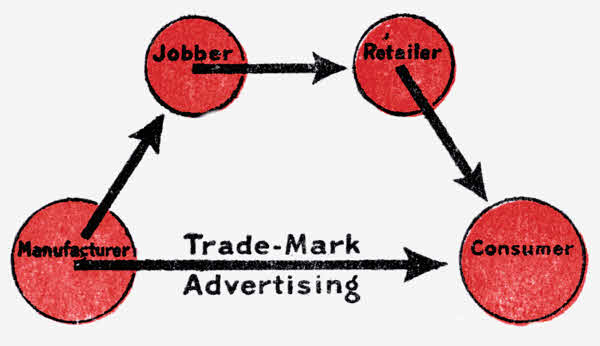
This looks like a problem in geometry, but it isn't.
This diagram shows at a glance how Trade-Mark Advertising draws a straight line between the manufacturer and the consumer.
The manufacturer who doesn't advertise has to depend on the jobber and the retailer. In the majority of cases his name never reaches the consumer. His trade is necessarily precarious, and he is constantly in danger of the kind of cut-throat competition that shaves the lowest margin of profit to nothing.
But the manufacturer who advertises has his name and the name of his goods on the lips of millions of people. The retailer who attempts to keep advertised goods from selling is like the man who cuts off his nose to spite his face. People will go elsewhere and get what they want.
We would like to talk with you about advertising. Among our clients are some of the largest and most successful advertisers in the United States. It will cost nothing to have a talk with us—and we may be able to suggest an idea or plan that will simplify your sales problem.
J. WALTER THOMPSON COMPANY
New York: 44 East 23rd Street
Boston: 201 Devonshire Street
Cincinnati: First National Bank Bldg.
St. Louis: Odd Fellows Bldg.
Chicago: The Rookery
Cleveland: Swetland Bldg.
Detroit: Trussed Concrete Bldg.
Toronto: Lumsden Bldg.
London: 33 Bedford St., Strand
A special provision of the Act of 1905 legalized all trade-marks that had been in exclusive use by the applicant for ten years prior to the passage of the act, and this provision applies even to trade-marks of ten years' standing that, because of their character, could not be registered under the act. The language of the act dealing with this subject is as follows:
"Nothing herein (in the Act of 1905) shall prevent the registration of any mark used by the applicant or his predecessors, or by those from whom title to the trade-mark is derived, in commerce with foreign nations or among the several states, or with Indian tribes, which was in actual and exclusive use as a trade-mark of the applicant or his predecessors from whom he derived title for ten[17] years next preceding the passage of this act." (Section 5, Act of 1905.)
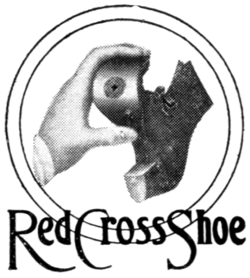
"It Bends with your Foot."
The trade-marks of the Red Cross Shoe are the Red Cross shown below and the design shown above.
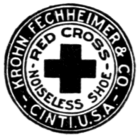
There are many trade-marks registered under this ten years' clause.
Manufacturers are prohibited from using the insignia of the Red Cross Society as a trade-mark, but there is a Red Cross Shoe, and the products of the well-known druggists' specialty house of Johnson & Johnson bear a Red Cross symbol. In both cases, their right is based on long and continuous use antedating the act of 1905, which especially exempts such cases.
The registration of trade-marks is under the supervision of the Commissioner of Patents, and regular forms for registration are prescribed. Copies of these forms may be obtained by applying to the Patent Office.
In applying for trade-mark registration, the following provisions of the law must be observed:
1st. The applicant must file a Petition in the Patent Office, addressed to the Commissioner of Patents. This petition must be in regular form, and should be signed and dated.

A valuable and widely advertised trade-mark. Can you guess what the three letters mean?
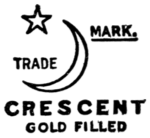
A trade-mark of the Keystone Watch Case Co.
2nd. With the petition a Statement must be forwarded. This document must give the name, domicile, location and citizenship of the applicant; the class of merchandise and the particular description of goods comprised in such class to which the trade-mark is appropriated; a statement of the[18] mode in which the trade-mark is to be affixed to the goods; and the length of time during which the trade-mark has been used. It is not necessary to give a written description of the trade-mark itself except when it contains colors not shown in the drawing. This statement must be signed by the applicant. Where a corporation is the applicant, the secretary should sign the statement. When a partnership is the applicant, any partner can sign, but the names of all the members of the firm must be given.
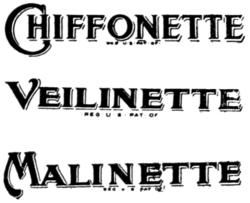
3rd. There should also be forwarded to the Patent Office, at the same time, a Declaration of the applicant, sworn to before a notary public, to the effect that he believes the statements made in his application are true; that he believes himself to be the owner of the trade-mark sought to be registered; and that said trade-mark is used by him in commerce among the several states of the United States, with the Indian tribes, or with foreign nations; and that the drawing sent with the application truly represents the trade-mark sought to be registered.
4. With this application there must be filed a Drawing of the trade-mark, made according to the following specifications: The size of the sheet on which the drawing is made must be exactly 10 x 15 inches, and the sheet must be of pure white paper, corresponding in thickness to two-sheet Bristol board. The surface of the paper must be calendered and smooth. India ink must be used. One inch from its edges a single marginal line must be drawn, as shown in the accompanying cut, leaving the dimensions inside the border exactly 8 x 13 inches.

Within this border, the drawing and signatures must be included. One of the shorter sides of the sheet is regarded as its top, and measuring downwardly from the marginal line, a space of not less than 1 1/4 inches is to be left blank for the heading of title, name, number and date. All drawing must be made with the pen only. Every line and letter, including signatures, must be absolutely black. The[19] name of the proprietor of the trade-mark, signed by himself, or his attorney of record, must be placed at the lower right-hand corner of the sheet within the marginal lines.
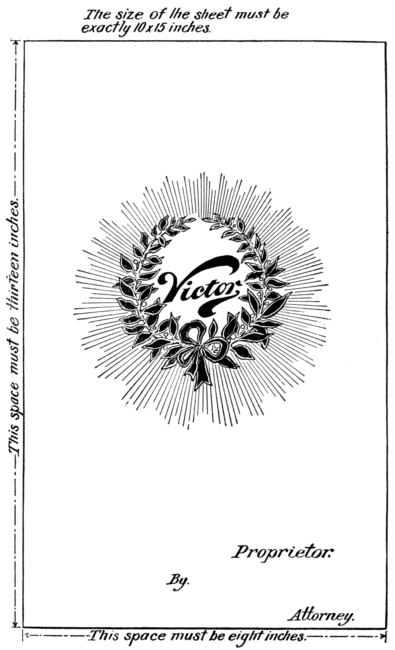
A Diagram Showing Method of Making Drawing
The drawing that accompanies an application for registration of a trade-mark must be made exactly on this pattern. It is essential that these directions be followed.

Coined word used as the name of a fountain pen.

The stork is the appropriate and suggestive trade-mark of the Stork Co. manufacturers of baby things.
5th. With the application five Specimens, or facsimiles, of the trade-mark as actually used upon the goods, must be sent to the Commissioner of Patents.
6th. The Fee for registering a trade-mark is ten dollars, and this amount should be sent with the application.

Trade-mark moulded into the reverse side of every Tapestry Brick.
The foregoing is a brief resumé of the rules for registration. Those intending to register trade-marks should obtain exact forms from the Commissioner of Patents.
A certificate of registration remains in force for twenty years, and it may be renewed from time to time, upon expiration, for like periods of twenty years, upon payment of a renewal fee of ten dollars.
The owner of a trade-mark may prosecute his own application for registration, but he is advised, unless familiar with such matters, to employ a competent attorney. A register of attorneys is kept in the Patent Office, on which is entered the names of all persons entitled to represent applicants before the Patent Office in the prosecution of applications for patents, and any registered attorney will be recognized in the prosecution of applications for registration of trade-marks.
The examiner in charge of trade-marks examines all applications for registration. If, after examination, registration is refused, the applicant will be notified, and the reasons for refusal stated, in order that the applicant may judge of the propriety of prosecuting his application further.
If, on examination of an application, it appears that a trade-mark is entitled to registration, the mark will be published at least once in the Official Gazette of the Patent Office. Such publication shall be at least thirty days prior to the date of registration.
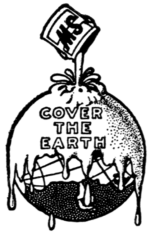
A Sherwin-Williams advertising symbol.
If no notice of opposition be filed within thirty days after such publication, the applicant or his attorney will be notified of the allowance of his application, and a certificate of registration will be granted.
Under certain conditions amendments may be made in an application.
Every applicant whose mark has been twice refused registration by the Examiner of Trade-marks for the same reasons upon grounds involving the merits of the application, may appeal to the Commissioner, in person, upon a payment of a fee of fifteen dollars.
From an adverse decision by the Commissioner of Patents an appeal may be taken to the Court of Appeals of the District of Columbia.
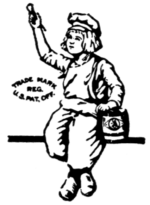
The well-known trade-mark of the National Lead Company.
If, upon examination of an application to register a trade-mark, the examiner in charge finds that the mark for which registration is sought is identical with, or essentially similar to, a trade-mark appropriated to goods of the same descriptive qualities, for which a certificate of registration has been already issued, an interference will be declared.
When an interference is declared, the matter in dispute is referred to the Commissioner of Patents, who, under the rules of the Patent Office, passes judgment upon the points at issue.
Any person who believes he would be damaged by the registration of a mark may oppose the same by filing a written notice of opposition, stating the grounds therefor, within thirty days after the publication of the mark sought to be registered, which notice of opposition shall be accompanied by the fee required by law ($10.00) and shall be verified by the person filing the same before one of the officers mentioned[22] in Section 2 of the Act of February 20, 1905.[1] An opposition may be filed by a duly authorized attorney, but such opposition shall be null and void unless duly verified by the opposer, within a reasonable time after such filing. A duplicate copy of the notice of opposition must be filed, either with the notice of opposition or within a reasonable time after the filing of the same.

All men, and some women, know what this stands for.
Any person, deeming himself to be injured by the registration of a trade-mark in the Patent Office, may, at any time, make application to the Commissioner to cancel the registration thereof. Such application shall be filed in duplicate, shall state the grounds for cancelation, and shall be verified by the person filing the same, before one of the officers mentioned in Section 2 of the Act of February 20, 1905.
If it shall appear, after a hearing before the examiner of interferences, that the registrant was not entitled to the use of the mark at the date of his application for registration thereof, or that the mark is not used by the registrant, or has been abandoned, and the examiner in charge of interferences shall so decide, the Commissioner shall cancel the registration of the mark, unless appeal be taken within the limit fixed.
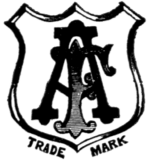
A weak and unimpressive trade-mark.
In cases of opposition, and of applications for cancelation, the examiner in charge of trade-marks shall forward the files and papers to the examiner in charge of interferences, who shall give notice thereof to the applicant or registrant. The applicant or registrant must make answer at such time, not less than thirty days from the day of the notice, as shall be fixed by the examiner in charge of interferences.
The law directs that the owner of a registered trade-mark print, or impress, or affix, in legible letters, the words:
Registered in U. S. Patent Office
or
Reg. U. S. Pat. Off.
upon such trade-mark wherever it is used, or sufficiently near it to be discerned whenever the trade-mark is seen. The manner in which this should be done is shown in connection with the "Fine-Form" Maternity Skirt trade-mark on this page. When, from the character or size of the trade-mark, or from its manner of attachment to the article, this cannot be done, a label containing a like notice should be affixed to the package or receptacle wherein the article is enclosed.

Shows method of exhibiting registry notice in connection with a trade-mark.
It is important that this be done, otherwise, in a suit for infringement by a party who has failed to give such notice of registration no damages shall be recovered, except on proof that the defendant was duly notified of infringement, and continued the same after such notice.
American owners of trade-marks who expect to do business in foreign countries should not neglect the registration of their trade-marks abroad. A failure to observe this precaution has led, in some cases, to a situation where the American owner, entering the foreign field, found his trade-mark already appropriated. The trade-mark laws of various foreign countries differ greatly, in some instances, from the United States law. A manufacturer who desires to do business in a foreign country should consult a trade-mark attorney who specializes in foreign trade-mark registration and protection, and be guided by his advice.
The right to use a trade-mark is limited to the class of merchandise for which it is registered, and to the goods, falling within that class, on which it has been actually used.
For the purpose of classification the Patent Office has issued a list of forty-nine general classes of merchandise. An applicant for the registration of a trade-mark must specify the class of merchandise with which his mark has been used, and must describe the particular goods in that class on which it has been used. In case his application is granted, his right to use the trade-mark is confined to the line of products named in his application.
The list follows:
1. Raw or partly prepared materials.
2. Receptacles.
3. Baggage, horse equipments, portfolios, and pocket-books.
4. Abrasive, detergent, and polishing materials.
5. Adhesives.
6. Chemicals, medicines, and pharmaceutical preparations.
7. Cordage.
8. Smokers' articles, not including tobacco products.
9. Explosives, firearms, equipments, and projectiles.
10. Fertilizers.
11. Inks and inking materials.
12. Construction materials.
13. Hardware and plumbing and steam-fitting supplies.
14. Metals and metal castings and forgings.
15. Oils and greases.
16. Paints and painters' materials.
17. Tobacco products.
19. Vehicles, not including engines.
20. Linoleum and oiled cloth.
21. Electrical apparatus, machines, and supplies.
22. Games, toys, and sporting goods.
23. Cutlery, machinery, and tools, and parts thereof.
24. Laundry appliances and machines.
25. Locks and safes.
26. Measuring and scientific appliances.
27. Horological instruments.
28. Jewelry and precious-metal ware.
29. Brooms, brushes, and dusters.
30. Crockery, earthenware, and porcelain.
31. Filters and refrigerators.
32. Furniture and upholstery.
33. Glassware.
34. Heating, lighting, and ventilating apparatus, not including electrical apparatus.
35. Belting, hose, machinery packing, and non-metallic tires.
36. Musical instruments and supplies.
37. Paper and stationery.
38. Prints and publications.
39. Clothing.
40. Fancy goods, furnishings, and notions.
41. Canes, parasols, and umbrellas.
42. Knitted, netted, and textile fabrics.
43. Thread and yarn.
44. Dental, medical, and surgical appliances.
45. Beverages, non-alcoholic.
46. Foods and ingredients of foods.
47. Wines.
48. Malt extracts and liquors.
49. Distilled alcoholic liquors.
50. Merchandise not otherwise classified.
(Note: Class 18 was abolished Feb. 24, 1909.)
As a result of this feature of the law products in various non-competitive lines sometimes bear the same names.[25] There is, for example, a Yale[2] lock and a Yale motorcycle, an Ideal hairbrush and an Ideal fountain pen, a Packard piano and a Packard automobile, a Skidoo soap and a Skidoo Marine engine.
Most states have some kind of a trade-mark law, many of them good ones, and about a dozen have strong penal codes covering the subject, under the term of counterfeiting, while others are able to do what the United States courts cannot do—actually mete out imprisonment to those who infringe. Pennsylvania's law in this respect is particularly thorough.
The Federal statutes concerning trade-marks apply to the entire country. Few large concerns doing a national business register in the states. Most of them go to the Patent Office and secure national registration.
There is nothing in any of the state laws which make it safer to register by states, since California's obnoxious law has been repealed, but in some cases, where persistent infringers are at work, owners of trade-marks secure state registration as an extra precaution.
To a layman the trade-mark law seems, at first consideration, to be a crystallized system of arbitrary rules without a fundamental underlying principle.
A study of its application will show that this is a mistaken view of the case. As a matter of fact, the law is excellently framed, and is based on a broad principle which draws a just line of cleavage between the rights of an individual and his encroachment upon the rights of others.
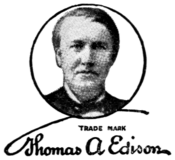
An illustrious and valuable trade-mark.
In the practical workings of a law which deals with commercial activities in their most highly developed phase, in a sphere where the ingenuity of men is on fertile ground, in cases where the weight of a hair would make the difference between yea and nay, it is inevitable that many fine distinctions must be drawn.
The courts, by contradictory decisions, have here and there brought confusion into the practice of the Patent Office, as applied to trade-mark procedure, but, on the whole, the judicial interpretation of the law has been fairly uniform and consistent.
It should be mentioned here, for the reader's information, that the attitude of the Patent Office toward applications for the registration of trade-marks has been criticized, on various occasions, by some of those who have had dealings with it. Its rulings have been characterized as narrow and illiberal, especially in the matter of trade-marks alleged to be descriptive in their nature.
In the preceding chapter we laid down briefly the requisites of a valid trade-mark. We shall now discuss these[27] requirements more fully, using specific and generally well-known examples of trade-marks to illustrate our meaning.
This section of the law is based on the recognized right of any person to prohibit the unauthorized reproduction of his portrait for any advertising purpose. In some of the states—New York, for example—there are state laws specifically forbidding such unauthorized reproduction.
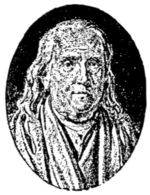
Registered as a trade-mark by the Saturday Evening Post.
While the law prohibits the registration of a living individual's portrait as a trade-mark, without that person's consent, it is allowable to use the portrait of a historical character.
The trade-mark of the Robert Burns Cigar is a picture of the poet Burns, with his facsimile signature.
Pictures of Franklin, Napoleon, Henry Clay, Bismarck, and many other famous men are used as trade-marks. A cereal recently placed on the market under the name of "Washington Crisps" carries George Washington's portrait on the package.
Benjamin Franklin's face is registered as a trade-mark by the Curtis Publishing Company, and is printed in this connection on the editorial page of the Saturday Evening Post.
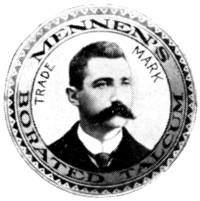
This face has been printed more times than any other portrait ever used in advertising.
A celebrated instance of a face used as a trade-mark is shown in the picture of Gerhard Mennen on this page. Mennen's Talcum Powder was produced by Gerhard Mennen, who had his own picture put on each package as an identification to the purchaser. After years of use, his portrait was formally registered in the Patent Office.
Another famous face is that of W. L. Douglas, shoe manufacturer and Ex-Governor of Massachusetts.
A very effective trade-mark is a combination of Thomas A. Edison's portrait and signature, used with the Edison Phonograph. Edison is known by reputation to every American, and his picture and signature used in connection with a mechanical device, give it the stamp of high excellence. Imagine how much more difficult the selling effort of the Edison Phonograph Company would have been if they had called their instrument The Voltex Phonograph, for example, or some similar name.
Everybody has seen the Woodbury face, which is identified with Woodbury's Facial Soap, and other preparations of the Andrew Jergens Company of Cincinnati. This is a very valuable trade-mark, on account of the extensive advertising, running through many years, that has been given it. One of the striking features of this trade-mark is that the head seems to be neatly decapitated just under the chin. This odd appearance makes the memory of this picture stick in the reader's mind longer than any ordinary portrayal of a human face.
The intent of the law here is to prevent the individual appropriation of general terms descriptive of a class of goods. If it were allowable to register and protect such phrases as "The Best Soap in the World", applied to a certain brand of soap, for instance, it is easy to see that all desirable superlatives and descriptive words would soon be appropriated, to the detriment of other concerns in the same line of trade. Therefore, the law makes strict provision that a trade-mark shall not be descriptive in any sense.
Though this is the intent of the law, in its working out the line seems to be finely drawn in some cases.
"Royal" has been held to be a valid trade-mark for a baking powder on the ground that it has been long used as the name of the total output of a factory, and that it has become to the public mind a designation of origin. It seems difficult for a layman to reconcile this decision with that of another court, which held that "Royal" is not a valid trade-mark for flour, as it indicates "quality and is incapable of exclusive appropriation."
The word "Ideal" is held to be a valid trade-mark for a fountain pen, its use in this connection being fanciful and not descriptive.
The word "Naphtha", used as a name for a soap with naphtha as an ingredient, was held to be descriptive, and therefore not registrable as a trade-mark, to the exclusion of the goods of other manufacturers, although the owners, Fels & Company, of Philadelphia, had advertised it extensively throughout a considerable period of time.
"Fitmeeasy", as applied to corsets, was considered descriptive.
"Maltha" was refused registration for a brand of paving asphalt. It appears that "Maltha" means liquid asphalt and is in general use in the trade with that meaning.
"Elastic Seam", a name used to designate drawers having an elastic seam at the side, is purely descriptive, and was so considered by the court in the case of Scriven v North.
On the other hand, the word "Elastic", when applied to bookcases, is held to be a fanciful word, not descriptive, and is a valid trade-mark.
Application was made by a brewer for the registration of the word "Star", accompanied by a picture of a six-pointed star, as a trade-mark for beer. Opposition by another brewer was filed, and it was shown that both the word "Star" and the symbol had been used for ages in Germany, the home of beer, as a general sign of the brewing business, in the same sense that a striped pole denotes a barber. It was claimed, and the claim was judicially sustained, that both the word "Star" and its symbol are indicative of the brewing business in general and, as such, are common to the trade, and cannot therefore be considered valid trade-marks for beer.

A flour manufacturer conceived the idea of selling his product in barrels made by staves of alternately light and[30] dark wood—striped barrels, in fact. He then desired registration for a trade-mark which consisted of a pictorial representation of this form of barrel. It was held that this mark was not registrable, as it was descriptive of the barrel.
"Better than Mother's" Mince Meat was held to be invalid as a trade-mark, as it is obviously indicative of quality.
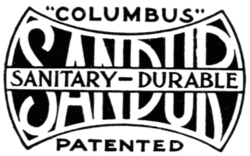
A complicated and involved trade-mark.
A descriptive word in a foreign language cannot be exclusively, appropriated as a trade-mark. The word "Matzoon" in Armenian means "fermented milk". It was held, in the case of Dadirrian v Yacubian that this word, applied to a preparation of fermented milk, was not a valid trade-mark.
Arbitrary symbols, numbers or words in common use in any line of trade to designate grades, or varieties, of products, are held to have become descriptive by usage. "Lake", "Cylinder", and "New York" are trade names used to indicate qualities of glass. They were refused registration on the ground that they were descriptive appellatives. Note that one of the names, "New York", would have been considered invalid on the ground of being a geographical term.
"A No. 1", "A X No. 1" and "No. 1", used by a plow manufacturer to indicate size and shape of plows, were considered descriptive terms, and, therefore, not valid trade-marks.
While descriptive numbers cannot be registered as trade-marks, it is permitted to register numbers that are used as arbitrary symbols. A celebrated instance of a number used as a trade-mark is "4711" used to designate a line of toilet articles. When the manufacture of the famous "4711" Perfume began, the owner's place of business was at 4711 Glockengasse, in Cologne. The street number "4711" was placed on the label, and it is to-day one of the oldest trade-marks in existence, having been used for about one hundred and twenty-five years. The house at 4711 Glockengasse has long since disappeared, and "4711" is now only an arbitrary symbol.
A manufacturer of hooks and eyes applied for registration of the phrase "Rust? Never!" as a trade-mark. Registration was refused, as the mark was held to be descriptive, indicating that the hooks and eyes would never rust.
The
J. W. T.
Advertising
Service
An advertising agency's claim to an advertiser's consideration must be based on the service that it gives.
Service consists of:—
1st. Information as to advertising mediums, their circulations, rates and qualities.
2nd. Advice resting on actual experience.
3rd. Knowledge of commodities, their composition, prices and methods of sale.
4th. Knowledge of merchandising conditions.
5th. Knowledge of the buying public, its needs, its habits and its income.
6th. The ability to plan advertising campaigns—that is, to grasp the whole subject and work out its details in conformity with a general principle.
7th. Knowledge of trade-marks, their use in advertising, and methods of protecting them from infringement.
8th. The ability to write advertising that will create a desire for the advertised product.
9th. The artistic ability to make advertising attractive.
The service of the J. Walter Thompson Company covers all these functions of an advertising agency.
We have had a continuous experience of forty-six years in planning and carrying out advertising campaigns.
We have reached the stage of development where we know advertising as a swimmer knows the water.
Doesn't it seem good business to entrust your advertising to an agency that really knows?
J. WALTER THOMPSON COMPANY
New York: 44 East 23rd Street
Boston: 201 Devonshire Street
Cincinnati: First National Bank Bldg.
St. Louis: Odd Fellows Bldg.
Chicago: The Rookery
Cleveland: Swetland Bldg.
Detroit: Trussed Concrete Bldg.
Toronto: Lumsden Bldg.
London: 33 Bedford St., Strand
It should be noted that there are valid trade-marks that seem to be descriptive, and which no doubt convey to the purchaser the suggestion of quality, but which are not really descriptive, but merely suggestive. An example of this is "Hydegrade" as applied to fabrics. This word is a combination of "Hyde" (the name of the proprietor) and "Grade". The word, by virtue of its sound, brings to the mind the idea of "high-grade"—a very fortuitous circumstance, doubtless, in the opinion of the owners.

Affixed by using perforated letters. Trade-mark appears on every yard of Brenlin window shades.
Names, descriptive in their nature, and therefore not registrable under the Act of 1905, may, nevertheless, be protected by the law of unfair competition, if the circumstances are such as clearly to indicate that a new user of the name has adopted it for the purpose of trading upon the reputation of an older or more widely known concern.
A fraud cannot be legalized, and a misrepresentation of any kind, made by a trade-mark, renders it invalid.
"Syrup of Figs" was held to be invalid as a trade-mark, and not protectable, in a case where the product was shown to have only a trace of fig syrup.
The title "American Sardines", applied to fish which were not sardines, was considered a misrepresentation, and was refused registration.
(Note: Even if not a misrepresentation, it would be considered invalid, as it is descriptive.)
In the case of Wrisley v Iowa Soap Company, it was held that the name "Old Country Soap" used on soap and advertised in such a way as to lead people to believe that it was made in Europe, was deceptive and protection to the name could not be given.
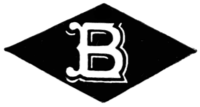
A trade-mark that may be considered good or bad, depending on the way you look at it.
An interesting case is that of Memphis Keeley Institute v Leslie E. Keeley Co. (144 Fed. R. 628; 155 id. 964).
The Memphis Keeley Institute made a contract with the Leslie E. Keeley Company to represent the[32] Keeley Company in Tennessee in treating inebriates. The Keeley Company agreed to sell the Keeley Cure to no one in Tennessee except through the Memphis Institute.
After a while the Keeley Company claimed that the Memphis Institute had violated its contract, and refused to furnish any more of the treatment to the Memphis concern.
The Memphis Institute continued to advertise itself as the representative of the Keeley Company, and to assert that its treatment was that of the Keeley Company.

A coined word used as a trade-mark.
Suit being brought, the Memphis Institute alleged that the complainant's representations of the ingredients of its remedies were untrue and misleading. The Keeley Company had extensively advertised its treatment as the "Gold Cure". It was shown in court that it contained no gold in any form; that in the beginning chloride of gold had been used in one instance, and that it had almost killed the patient; and that special bottles of the cure had been prepared with gold in them in order that a chemist might be deceived; and that this chemist's analysis of the spurious bottles had been extensively advertised as showing that gold was in the remedy.
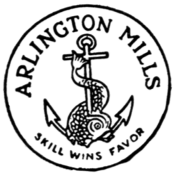
A simple and effective trade-mark.
On the evidence of these misrepresentations, the Court of Appeals reversed the decision of the lower court, and dismissed the complaint.
The doctrine of law that misrepresentation is a bar to protection of a trade-mark or a trade-name has been clearly established by many decisions similar to the above.
When a pictorial or symbolic device has been registered, registration is refused to any other mark, for the same class of merchandise, composed of words describing the pictorial or symbolic device already registered. Or, vice versa, if the wording has been registered first, a symbol with the same meaning will be denied registration. For example:—
A trade-mark consisting of the conventional representation of a fox, unaccompanied by lettering, would not be a valid trade-mark if the word "Fox" had already been registered for the same class of merchandise. In either case the goods would be called the "Fox" brand.
The practice is to refuse registration of a mark in cases where, although there may be no literal similarity, there is a similarity in ideas.
"Edelweiss-Maltine" was refused registration on the ground that it conflicted with "Maltine", a trade-mark already registered for goods of the same description.
"Certosa" was refused registration as a trade-mark for flour on account of its similarity to the word "Ceresota" already registered.
The Patent Office has held that in an interference between two trade-marks, one consisting of the pictorial representation of a bouquet of flowers, and the other consisting of the word "Bouquet", applied to the same class of goods, that the marks were identical in meaning.
"Nassac" having been registered as a trade-mark, the word "Nayassett" was refused registration on the ground of similarity. Thereupon, the owner of the "Nayassett" mark obtained the consent of the owners of "Nassac" to the registration of "Nayassett". This did not alter the case, in the opinion of the Commissioner of Patents, who held that the law was mandatory, and was not affected by agreement among the owners of conflicting marks.
In the case of McLean Co. v Adams Co. (136 Official Gazette, 440) it was held that there was no conflict between "Victoria" and "Victor", a mark already registered for the same class of merchandise. A picture of Queen Victoria's head was shown on a medallion, associated with the word "Victoria". The "Victor" trade-mark consisted of the words "The Victor" with a device showing a knight on horseback. As the similarity between the marks was obviously slight and superficial, and was outweighed by the dissimilar features, it was held that the "Victoria" trade-mark was entitled to registration.
It was held that there was no conflict between two trade-marks for stove polish, one consisting of the word "Raven" with the representation of a raven sitting on a limb of a tree, and the other consisting of the word "Crow" associated with a picture of a crow, also perched on a limb, but in a different position.
In case of conflicting marks the test of similarity is whether the marks are sufficiently alike in sound or in appearance, or in intention, to mislead the purchaser.
The object of this provision of the law is to prohibit the appropriation of the name of a place by an individual to the detriment of other manufacturers in the same locality, as well as to prevent a misrepresentation of the place of origin of a trade-marked article.
This restriction does not apply to geographical names used in an arbitrary or fanciful sense.

This shows how the reader's attention is called to the Dupont brush trade-mark in advertisements.
The Fleischman Company, well-known bakers of New York, bake and sell a Vienna Bread. The term "Vienna" used in this connection was held, in a test case, to be a valid trade-mark, although it is a geographical name.
In the decision bearing on the Vienna trade-mark for bread, the Court said: "As a mark for bread it is purely arbitrary, and is in no manner descriptive of the ingredients or the quality of the article. No deception is practised, because the place of its manufacture is given, and it is known that bread cannot be imported from abroad for use here."
"Durham", a name applied to tobacco, has been judicially held not to be a valid trade-mark against another manufacturer located in the town of Durham. While any tobacco manufacturer in Durham has a right to call his tobacco "Durham Tobacco", he cannot imitate the label of the original Durham tobacco, or use the advertising symbol of a bull, without being liable to injunction and a suit under the law of unfair competition.
"French", applied to paints, was considered a geographical name, and not valid as a trade-mark. "French Tissue"—the name of a court-plaster—was considered invalid, the first word being a geographical term and the second a descriptive word.
The word "Celtic", however, has been considered valid as a trade-mark for tea. The Commissioner of Patents, before whom the case went on an appeal, decided that while "Grecian", "Roman" and "Oriental" had been held to be geographical, as each of these terms refers to a certain section of the globe, the word "Celtic" is not. There seems to be no authority to sustain the popular opinion that "Celtic" refers only to Ireland. The dictionary defines "Celtic" as "pertaining to the Celts", of whom the Irish are only a branch. It has never been applied to any specific locality.
"Yucatan" applied to leather; "Manhattan" as the name of sewing-machines; and "Pittsburgh" as a trade-mark on pumps, have all been held to be geographical, and therefore invalid.
In a recent decision of the Supreme Court, the exclusive right of the Carthusian monks to use their well-known trade-mark for their Liqueur Chartreuse, was upheld. This right was attacked on the ground that Chartreuse is a geographical name, the liqueur having been made at a monastery called for many centuries "La Grande Chartreuse".
In his opinion Mr. Justice Hughes said:
"If it be assumed that the monks took their name from the region in France in which they settled in the eleventh century, it still remains true that it became peculiarly their designation. And the word 'Chartreuse', as applied to the liqueur, which for generations they made and sold, cannot be regarded in a proper sense as a geographical name. It had exclusive reference to the fact that it was the liqueur made by the Carthusian monks at their monastery. So far as it embraced the notion of place, the description was not of district, but of the monastery of the order—the abode of the monks—and the term, in its entirety, pointed to production by the monks."
While a geographical name may be upheld as a valid trade-mark, under exceptional conditions—as shown in the Fleischman case—the safe plan to follow is to avoid names of this character when selecting a trade-mark.
Under the collection of legal precedents constituting the law of unfair trade, the owner of a geographical trade-mark may successfully defend his right to its exclusive use if he[36] has acquired such a reputation under it that it has grown to be, in the public mind, an arbitrary designation of his goods.
The American Waltham Watch Company, manufacturing watches at Waltham, Massachusetts, has legally prevented other manufacturers in Waltham from calling their product "Waltham" watches unless the name is used with some accompanying statement which clearly distinguishes these watches from the original Waltham watch.
There is an Elgin Watch, a Kalamazoo Stove and a Bristol Fishing-Rod, to single out a few examples of geographical terms used as trade-marks. The exclusive use of these trade-marks by the makers of the well-known articles which they represent can no doubt be legally sustained on the ground that these names have become arbitrarily identified, through years of use and extensive distribution, with the articles to which they are applied, and that their indiscriminate use would cause confusion in the public mind and loss to the original owners.
Their security as trade-marks rests, not upon the letter of the trade-mark act, but upon the law of unfair trade.
The Act of 1905 (the trade-mark statute) is silent on the subject of the Red Cross as a trade-mark. Its use as a trade-mark, or as an advertisement, or in trade in any form, is prohibited by the act incorporating the American National Red Cross, approved January 5, 1905. An extract from this act, bearing on this subject, is quoted here:
"Nor shall it be lawful for any person or corporation, other than the Red Cross of America, not now lawfully entitled to use the sign of the Red Cross, hereafter to use such sign or any insignia colored in imitation thereof for the purposes of trade, or as an advertisement to induce the sale of any article whatsoever. If any person violates the provisions of this section, he shall be guilty of a misdemeanor and shall be liable to a fine of not less than one nor more than five hundred dollars, or imprisonment for a term not exceeding one year, or both, for each and every offense. The fine so collected shall be paid to the American National Red Cross."
In the Official Gazette there is reported the case of an applicant who applied for registration of a label for cough[37] syrup, containing the emblem of the Red Cross and the words "Red Cross". This label having been refused registration, the applicant submitted it in an amended form with the Red Cross emblem left out, but with the wording left intact. It was contended by him that the Act of January 5, 1905, prohibited only the use of the "sign of the Red Cross", and that by implication the words "Red Cross" should be considered registrable. This contention of the applicant was held by the Commissioner to be an attempt to evade the spirit of the law, and registration was refused.
A trade-mark containing the Red Cross emblem does not fall within the prohibition expressed in the statute if it has been in exclusive use by the applicant for ten years prior to 1905.
A surname cannot be the exclusive property of an individual, because there may be other persons who have an equal right to use the same name. A man by the name of Jones may go into the business of manufacturing cigars, for example, and he may call his product "Jones Cigars" and, by his industry and ability, create a valuable business.
But any other Jones has a right to manufacture and sell cigars, if he feels so inclined, and the first Jones cannot prevent it. It is true that, under the law of unfair trade, he may compel all other Joneses to mark their cigars in some distinctive manner, in order that purchasers may not be misled into the belief that they are buying the product of the original Jones, when such is not the case.
This principle is specifically illustrated in the famous Walter Baker cases, of which a brief resumé is given in another chapter.
An obvious intent of the framers of the Act of 1905 was to discourage the use of the names of "individuals, firms, corporations and associations" as trade-marks.
Consequently, it was provided in the act that names of this character should not be registered unless they were "written, printed, impressed or woven in some particular or distinctive manner, or used in connection with the portrait of the individual."
The ruling of the Patent Office, which has been sustained by the courts, is that the particular or distinctive manner of presenting the name must exhibit a peculiarity so pronounced that it dominates the name, and throws it into relatively secondary importance. In other words, a trade-mark of this character, to be registrable, must possess more of the quality of a device than of a name.
It is conceded that an autograph signature, like "Wilcox's", shown on this page, is entitled to registration.
Soon after the law went into effect a curious tangle developed in the application of this feature of the act.
It was found that the Patent Office—and its stand was upheld by the Court of Appeals of the District of Columbia—would not sanction the registration of a name possessing all the technical requisites of a valid trade-mark if it happened to be the name of the applicant, unless it was written or printed in some particular and distinctive form.

Written in a "particular and distinctive manner" within the meaning of the law.
To a legal mind there may have been some good reason for this attitude of the court, but a layman of ordinary common sense can find nothing in the statute that would justify a refusal to register a trade-mark, valid in other respects, merely because it happened to be the name of the person, corporation, or firm making the application.
The name "Success", a valid mark in every essential respect, was refused registration as a trade-mark for Success Magazine, because it formed part of the name of the applicant, The Success Magazine Company.
The ruling of the court left the implication that if Success Magazine had been published by John Brown & Co., or by any other concern other than the Success Magazine Company, registration would have been granted. It was held that a registration of the name "Success" would be a violation of that provision of the law providing that a mark consisting merely of the name of the applicant could not be registered.
The word "Champion", as a trade-mark for locks, was rejected by the Patent Office on the ground that it formed part of the name of the Champion Safety Lock Company. The word "Champion" is arbitrary and fanciful, and could no doubt have been registered by any other firm than the Champion Safety Lock Company.
Many other similar cases developed during the first six years of the law's application. This situation led to the passage on February 8, 1911, of the following amendment of this section of the Act of 1905:
"Provided, further that nothing herein shall prevent the registration of a trade-mark otherwise registrable because of its being the name of the applicant or a portion thereof."
It is now practicable to register the name of any individual, firm, corporation or association—even if it is the name of the applicant—provided it is "written, printed, impressed or woven, in some particular or distinctive manner."
This name turns up when the time comes to hang the window shades.
A familiar example of the name of an individual used as a trade-mark is to be found on every Hartshorn shade roller, where the name "Stewart Hartshorn", written as an autograph signature, has been used for many years. The name "Huyler's", applied to confectionery, is another case of the same kind.
The name "John Wanamaker" has, by long usage in connection with a highly successful mercantile business, become the most valuable trade-mark in the department store world.
"Stewart Hartshorn", "Huyler's", and "John Wanamaker" are all common law marks, fully protected by the law of unfair trade.
The intent of the law is to prohibit any individual from trading on the reputation of a fraternal order.
Registration was refused for the phrase "Knights of Labor" as a trade-mark on whiskey.
It has been decided in one case where an application was made to register the coat of arms of Maryland, that it could not be registered even under the ten years' clause.
Simulations of the coat of arms of the United States, or of the United States flag, have been denied registration.
The U. S. Sanitary Manufacturing Co. was refused registration for a trade-mark consisting of the letters "U. S." with a background of a shield similar to that of the conventional United States shield.
In the case of Popoff Frères, importers, registration of a mark including the Russian coat of arms was refused, although proof was shown that the Russian government had authorized the applicants to use this coat of arms as their trade-mark. The Commissioner held that the law could not be set aside by agreement.
The reader is doubtless familiar with the trade-mark of the United Cigar Stores—a shield consisting of a background at the top with the word "Cigars" on it, with the word "United" forming the lower part of the design. The vertical lines form seven heavy strokes, corresponding to the seven red stripes in the American flag. This design is suggestive of the United States coat of arms, but it is so cleverly worked out that it does not come within the prohibition expressed in the law. Suggestive as this design is of the American shield, this feature is secondary, after all, for the design is dominated by the lettering "United" and "Cigars."
It is clear that a trade-mark must be a "mark"—not a box, or an envelope, or container of any kind. In a case[41] where it was sought to register a drum-shaped box used to contain "Drum Collars", it was held that, "if such claims were allowed, the forms and materials of packages to contain articles and merchandise would be rapidly taken up, and appropriated by dealers, until some one bolder than the others, might go to the very root of things, and claim the primitive brown paper and tow strings."
A product itself cannot be registered as a trade-mark, for the "mark" must be different and separate from the thing marked.

One of the oldest trade-marks in existence. Used for generations as a trade-mark of Johann Maria Farina toilet preparations.
It would be unfair to give an exclusive right to use any particular color to an individual, consequently a color is not a valid trade-mark.
A seed-grower, selling his product in bags, applied for registration of a red bag as a trade-mark, but registration was refused.
A fountain pen manufacturer was refused registration for a trade-mark for fountain pens, consisting of a red feed bar contrasted with a black reservoir of hard rubber. The applicant stated that the feed bar was colored red in the manufacturing process, and that it was composed of rubber made by a special formula. The Court of Appeals held that registration of this device would give the applicant a virtual monopoly of this feature.
The Underwood Typewriter Co. applied for registration of the face-plate of their machine as a trade-mark. It is a principle of the trade-mark law that a part of a machine, or the form of an article, cannot be a valid trade-mark. Reporting this case, the Bulletin of the United States Trade-mark Association for January, 1908, says:
"The applicant, in the instance under adjudication, sought to avoid this principle of law, by contending that the case did not fall within that doctrine, for the reason that the plate which he sought to register was not really a part of the machine, since it could be removed without changing the shape of the machine, or interfering with its operation, or altering its structure. It was held, however, that while the plate performed none of the mechanical functions of the machine it was nevertheless a part of the machine as actually constructed, and was as essential as the frame itself to the production of a commercial article. It was necessary to give a finished appearance to the machine, which would not be salable without it. To recognize the applicant's right to a trade-mark in that feature of[42] the machine, would enable the applicant to prevent the manufacture of its machines as constructed to-day, after all the patents covering it had expired, since no salable machine could be produced without infringing the trade-mark."
The common good takes precedence of the rights of individuals. This is a principle of equity which has run through the fabric of Anglo-Saxon law for a thousand years. We find it developed into diverse and widely separated forms. On one hand, it appears as the right of eminent domain; in another form we find it appearing in a law prohibiting the use of the national flag for advertising purposes.
This principle is observed by the Patent Office and the courts in dealing with questions relating to trade-marks.
A trade-mark, otherwise registrable, and consisting of a device or wording not prohibited by the statute, may be refused registration if opposed to public policy.
The application of the Banner Cigar Mfg. Co. (138 Official Gazette, 528) for registration of the portrait and facsimile signature of the late Ex-President Grover Cleveland as a trade-mark was refused, the Commissioner of Patents holding that the use of a trade-mark of this character would detract from the dignity of the high office of President.
The portrait and facsimile signature of Thomas Jefferson was refused registration on the same grounds.
It should be noted that there is no law to prevent any manufacturer desirous of using the name and portrait of an Ex-President (not living) as a trade-mark if he cares to do so, but he cannot register such a trade-mark, and his ability to protect it in the courts in case of infringement is conjectural.
The word "Copyright", the name of a brand of flour, was refused registration on the ground that its registration would be opposed to public policy, since its use in connection with the phrase "Registered in the United States Patent Office" would be likely to impress buyers with the idea that the flour had been approved officially. It was also stated by the Commissioner, before whom the application went on appeal, that its registration might be used to annoy other flour manufacturers, who are obliged by law to give notice[43] of copyright on their labels, by using the word "Copyright" with the date and name of the owner.
The R. M. Rose Company was refused registration for the words "Ask the Revenue Officer" as a trade-mark for whiskey. The objection is that this trade-mark might lead purchasers to believe that the quality of the whiskey thus branded has the approval of the government.
For the same reason the word "Government" was refused registration as a trade-mark for loose-leaf binders.
A trade-mark that is not affixed to the goods for which it is registered cannot be protected in the courts.
A mark, or design, or name, that is used only in advertising is not a trade-mark but an advertising symbol. Affixation is an essential requisite of validity in trade-marks.

The trade-mark word "Simmons" is affixed on chains by stamping it in minute letters on the swivel of the chain.
The trade-mark may be written, or printed, or pasted, or stenciled, or branded, or woven, or sewed, upon the article with which it is used.
When it is not feasible to affix it to the article itself, as in case of liquids and many other commodities, the trade-mark must be affixed to the container.
Many ingenious devices are used by manufacturers in affixing trade-marks. The trade-mark "Brenlin", on Brenlin window shades, is placed upon every yard of the fabric in small perforated letters. The name appears near the selvage on each side of the goods.
The name "Aurora", applied to portieres and similar hangings, is to be found woven in the pattern of the fabric near the ends of each piece. The trade-mark blends into the pattern in such a way that it is inconspicuous, but may be readily found upon looking for it.
The London Feather Company's "London Plumes" trade-mark is cleverly affixed, being in the shape of a diminutive celluloid label, to the inside of the stem of each ostrich plume. The label is sewed on in such a manner that if it is cut out the plume falls apart.
This trade-mark is stenciled on duck sail cloth.
Makers of clothing generally affix their trade-marks to each garment in the shape of a sewed label. Manufacturers of rubber goods, such as rubber tires, water bags, etc., mold the trade-mark into the article itself. The "Lowell Duck" trade-mark, used on sail cloth, is stenciled at regular intervals on the selvage. The Corticelli kitten, which is the registered trade-mark of Corticelli Spool Silk, appears on the label at the end of each spool.
Moet & Chandon, and other champagne producers, have adopted the unique method of affixing their trade-marks to the bottom of the corks of their bottles. The trade-mark is not seen, of course, until the bottle has been opened. This method of affixation has been sustained by the courts. The logic of it is that it prevents an unscrupulous retailer from washing the label off a bottle of wine and pasting a spurious label in its place, provided the purchaser knows where to look for the trade-mark.
The main difference between a trade-mark and an "advertising character" is in the matter of affixation. A trade-mark, to be valid, must be affixed to the goods, while an advertising character is often used only in the advertisements of the product, though most advertisers use their trade-marks also in advertising.
But there is another difference. A trade-mark is inflexible. After having been once adopted and registered, it cannot be changed in design or wording. If changes are made in it, the validity of the trade-mark is vitiated proportionately. On the other hand, all kinds of changes are being constantly made in advertising characters, though advertisers are careful to preserve the main features of a character, after having adopted it, in order that it may be the touchstone of remembrance in the reader's mind.
It has occurred to various advertisers, who have been impressed by the infinite variety of pictures in advertising, that it would be a good idea for them to put some permanent pictorial feature in their advertisements. This feature—a human figure, or a decoration, or a group of figures—serves as an identifying landmark to the voyager in these weltering seas of change. With this principle established and followed year after year in all advertisements of any product, it is feasible to change the entire artistic treatment of the subject from time to time, yet still hold to the symbolic figures which connect, in the reader's mind, all the past advertising with the new series.
This line of reasoning underlies the adoption and use of advertising characters.
An "advertising character"—this is a rather crude term, but it seems to express the idea better than anything else—differs from an advertising illustration in that the character is carried on continuously in the advertising, in some form, while an illustration is dropped for something new.
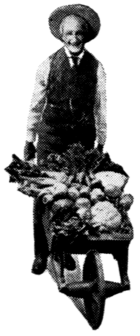
Peter Henderson's famous gardener.
For example, Peter Henderson's gardener appears, and has appeared, in every advertisement of Peter Henderson's seeds for many years. In most of the Peter Henderson advertisements, the gardener is the only illustration.
The Lackawanna Railroad has used Phoebe Snow for many years in its advertisements as its star passenger on the dirtless and dustless road to Buffalo. The scheme of picturing this dainty white-clad girl in connection with the advertising of a railroad is based on a very clever idea. Railroad journeys are generally supposed to be dusty and uncomfortable; but here is an attractive young lady who does not even go to the trouble of changing her white dress when she makes a trip on the Lackawanna. The use of Phoebe Snow as an advertising symbol is suggestive of the cleanliness and comfort and safety of the road.

The Dutch boy is taken out of the trade-mark and made to do stunts.
It sometimes happens that an advertising character is a figure or a device that has been formally adopted as a trade-mark of the advertiser's product. The National Lead Company's Dutch painter boy is a device of this kind. While a trade-mark must not be changed, a human figure, used as the trade-mark, may be put into another illustration, and used separately. This has been done in the National Lead Company's advertising. Their Dutch Boy has been depicted in the act of painting a house, and in giving a lecture on paint.
The Gold Dust Twins have been engaged in laborious but joyous tasks of various kinds since about 1880. Gold Dust was first made in 1883, but the twins, not called at that time "The Gold Dust Twins" had been a house trade-mark of the N. K. Fairbank Company for two or three years before that.

The trade-mark of the Prudential Insurance Company.
One of the most widely known symbols ever used in advertising is the representation of the Rock of Gibraltar,[47] which is a feature of the Prudential Insurance Company's advertising. There is hardly any doubt that pictures of the Rock have been printed more times in connection with the Prudential advertising than in all other forms of representation that have been issued since the art of printed illustration began.
The conception of the Victor dog, with his head inclined in a curiously suggestive listening attitude, before the mouthpiece of a phonograph, with the caption, "His Master's Voice", under the picture, is an idea that ought to rank among the productions of genius. It would be interesting to know what the Victor Talking Machine Company thinks its dog is worth.

A lady with a smile as inscrutable as that of Mono Lisa. The advertising symbol of Hubert's Malvina Cream.
Hubert's Malvina Cream advertising carries a peculiar but strikingly effective diamond-shaped device showing a woman's smiling face.
The American Bankers' Association, which issues travelers' cheques, good in every part of the world, has adopted a couple of travelers—evidently a young man and his wife on their honeymoon trip—as advertising characters. This well-groomed couple is shown, in the various advertisements, on the deck of a steamship, before the Pyramids, in a Venetian gondola, buying curios in the Orient, and in other places. Before they settle down they will have covered as many leagues as the Wandering Jew.
The Dutch Cleanser woman, in her eternal chase of dirt, is one of the best-known advertising characters in current use. This character is also the trade-mark of the product, and appears on cans of Dutch Cleanser.
It would be hard to beat this Dutch Cleanser woman as an eye-catcher. She shows motion, energy in action, and the device has an attractive simplicity.

This striking figure of a mountain climber is Peter's Chocolate Mountaineer. He has reached the summit of the Jungfrau and is waving his hand to his friends in the valley to let them know he is there, and that he is about to eat his chocolate.
An Alpine mountaineer, used as an advertising character[48] of Peter's Chocolate, has become well-known to every magazine reader in the country. The use of this figure harmonizes with the phrase "high as the Alps in quality", which is used in the Peter's Chocolate advertising.
The advantage to be gained, in the long run, by adopting a catchy and attractive advertising character, is shown by the nation-wide popularity of the Campbell "Kids". Everybody knows them and their rippling jingles, and they have no doubt become immensely valuable to the concern that owns them.
The law of unfair competition protects an advertiser in the use of an advertising character when the character is the advertiser's own creation.
In cases where living models are used for this purpose, the advertiser should remember that a model has a right to sell his services—that is, to pose—for anybody he pleases. Some advertisers make a contract of long duration with the models they intend to use, binding them to an agreement not to pose for any other commercial purpose.
Catch-phrases used in advertising, like Ivory Soap's famous "It Floats", and Bon Ami's "Hasn't Scratched Yet" are protectable against infringement and unauthorized use by another than the owner, through the same principle of law which gives protection to a manufacturer against a competitor who has imitated his packages, labels and circulars.
An advertiser's exclusive right to a catch-phrase is conditional on its constant and persistent use by him. An intermittent use does not establish a right to use it to the exclusion of others, nor does a use of the phrase in varying forms of wording, even if the sense of it is preserved, establish such a right.
It is hardly necessary to say that an exclusive right cannot be created for a phrase that is not distinctive, such as "Your Opportunity", "Clip the Coupon", etc. The common language is free to all, and an advertiser cannot prevent[49] others from using a phrase in their advertisements merely because he used it in his advertisements first, unless he can prove that they are using his language with the intention of misleading the public.
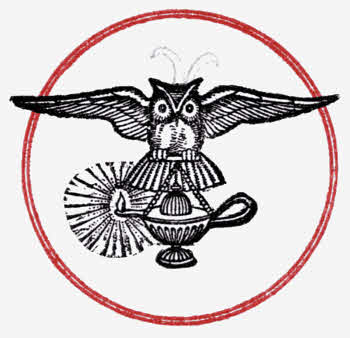
The Owl
And The Lamp
The owl is the symbol of wisdom—and wisdom means experience, judgment, and knowledge, combined with common-sense.
The lamp is the symbol of light and clearness of vision. Used in its figurative sense it is as old as civilization, for the ancients held the sign of a lamp to mean the power of imagination, illuminating the future.
The symbol of the owl and the lamp combined means Light leading Wisdom.
This is the advertising symbol of the J. Walter Thompson Company. For many years it has been the trade-mark of good advertising.
J. WALTER THOMPSON COMPANY
New York: 44 East 23rd Street
Boston: 201 Devonshire Street
Cincinnati: First National Bank Bldg.
St. Louis: Odd Fellows Bldg.
Chicago: The Rookery
Cleveland: Swetland Bldg.
Detroit: Trussed Concrete Bldg.
Toronto: Lumsden Bldg.
London: 33 Bedford St., Strand
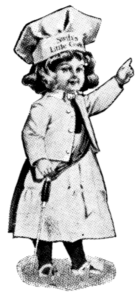
A clean and bright little fellow who adorns Swift & Company's advertising.
In the case of the unauthorized use of a well-known, extensively advertised catch-phrase, this intention is virtually obvious. For example, if any soap manufacturer should begin to print the N. K. Fairbank Company's celebrated question, "Have You a little Fairy in your Home?" in his advertisements and signs, the courts would doubtless enjoin him summarily, without inquiry into his intentions. This phrase has been used so long by the N. K. Fairbank Co., and so much money has been expended in giving it publicity, that its owners have acquired a valuable property right in it.
"Money invested in advertising is as much a part of a business as if invested in buildings or machinery, and when the goods of a manufacturer have become popular, not only because of their intrinsic worth, but also by reason of the ingenious, attractive and persistent manner in which they have become advertised, the good-will thus created is entitled to protection against unfair competition." (Hilson v Foster, 80 Fed. R. 896—1897.)
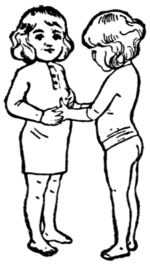
This is the advertising symbol used in Swift's Wool Soap advertising. The little boy in the receding undershirt used something "Just as good".
An interesting case of one concern attempting to profit by the advertising of another, was in the courts in 1907.
Kellogg's Toasted Corn Flakes were extensively advertised in a series of "blind" advertisements in newspapers on successive days. These advertisements, which were of large size and striking in appearance, showed the picture of a woman winking, with the admonition "Wink at Your Grocer and See What You Will Get", followed by the letters "K. T. C." in large type. The idea of the advertiser was to arouse curiosity by this form of advertising, and particularly by the letters "K. T. C." After considerable advertising of this kind he had planned to announce[50] that "K. T. C." meant "Kellogg's Toasted Corn Flakes", and that any woman might get a package of this preparation free if she would wink at her grocer.

This young couple can get cash anywhere on "A. B. A." Travelers' Cheques.
But before the final explanatory advertisements appeared, another concern selling "Cook's Flaked Rice", a similar product, caused advertisements to be printed in the same newspapers, in which they announced that "K. T. C." meant "Keep to Cook's".
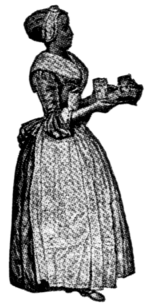
"La Belle Chocolatière," the trade-mark of Walter Baker's Chocolate.
The Kellogg firm obtained an injunction against this advertising on the ground of unfair competition, in that the defendant was misappropriating the good-will created by the Kellogg Company's advertising.
The widely advertised phrase used in the Pompeian Massage Cream advertisements, "Don't envy a good complexion; use Pompeian and have one", is the result of a prize contest, in which many thousands of people tried their skill at making phrases.
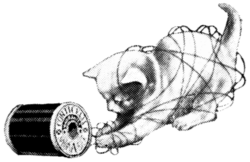
The Corticelli kitten, the advertising symbol of the Nonotuck Silk Co.
The Central Railroad of New Jersey, in advertising its New York to Philadelphia service, uses a phrase that is a complete advertisement of its train service in six words. Trains leave New York for Philadelphia every hour, leaving at ten o'clock, eleven o'clock, at noon, and so on. Every train leaves exactly on the hour.
The road formerly used the phrase: "Trains every hour on the hour", and this seemed to be pretty good, but it was thought that something better might be devised. A great deal of thought was given to the subject, and as a result the phrase "Your Watch Is Your Time Table" was devised. This phrase tells the whole story. It is no longer necessary to bother with time-tables when one goes from New York to Philadelphia. Just look at your watch. To visualize this idea, the phrase is used in the advertising[51] in connection with the pictures of a fast train and a watch.
A celebrated advertising phrase was "You press the button; we do the rest", formerly used by the Eastman Kodak Company. This sentence achieved a tremendous popularity, but it had the fundamental defect of not containing any word which would connect it closely with the Eastman Company's product. There is hardly a doubt that it was heard and used by a vast number of people who did not receive any Kodak-buying suggestion from it.
A short, incisive phrase which does not possess this defect is "O'Sullivanize Your Walk", used in the advertising of O'Sullivan's Rubber Heels. When you have a pair of O'Sullivan's Heels put on your shoes you do not merely invest in a comfort-giving device. It is a bigger transaction than that. You begin to walk like a man who means business—you have the erect and confident bearing of success—in short, you "O'Sullivanize Your Walk".
There is no intrinsic value in a trade-mark. Its worth in dollars is a creation, and it depends upon the successful sale, or popularity, of the commodity to which the trade-mark is applied, the distribution of this commodity, the extent to which it has been advertised, and the profit that there is in it.
Some widely-known trade-marks are worth millions of dollars, and many are valued at a hundred thousand dollars or more.
The ownership of an advertised and favorably known trade-mark is, therefore, a valuable property right. In estimating the assets of a business, its trade-mark is included under the head of Good-Will, and Good-Will is Reputation. The value of a trade-mark is the value of the reputation of the goods it represents and identifies.
A valuable trade-mark—like other valuable things—becomes, sooner or later, an object of envy on the part of those who want money without troubling themselves about the manner of getting it. Sometimes this leads to a more or less ingenious simulation of a trade-mark.
The remedy for the infringement of a registered trade-mark is covered by sections 16 to 19, inclusive, of the Act of 1905. We quote these sections of the law:
"Sec. 16. That the registration of a trade-mark under the provisions of this act shall be prima facie evidence of ownership. Any person who shall, without the consent of the owner thereof, reproduce, counterfeit, copy, or colorably imitate any such trade-mark and affix the same to merchandise of substantially the same descriptive properties as those set forth in the registration, or to labels, signs, prints, packages, wrappers, or receptacles intended to be used upon or in connection with the sale of merchandise of substantially the same descriptive properties as those set[53] forth in such registration, and shall use, or shall have used, such reproduction, counterfeit, copy or colorable imitation in commerce among the several states, or with a foreign nation, or with the Indian tribes, shall be liable to an action for damages therefor at the suit of the owner thereof; and whenever in any such action a verdict is rendered for the plaintiff, the court may enter judgment therein for any sum above the amount found by the verdict as the actual damages, according to the circumstances of the case, not exceeding three times the amount of such verdict, together with the costs.
"Sec. 17. That the Circuit and Territorial Courts of the United States and the Supreme Court of the District of Columbia shall have original jurisdiction, and the Circuit Courts of Appeal of the United States and the Court of Appeals of the District of Columbia shall have appellate jurisdiction of all suits at law or in equity respecting trade-marks registered in accordance with the provisions of this act, arising under the present act, without regard to the amount in controversy.
"Sec. 18. That writs of certiorari may be granted by the Supreme Court of the United States for the review of cases arising under this act in the same manner as provided for patent cases by the act creating the Circuit Court of Appeals.
"Sec. 19. That the several courts vested with jurisdiction of cases arising under the present act shall have power to grant injunctions, according to the course and principles of equity, to prevent the violation of any right of the owner of a trade-mark registered under this act, on such terms as the court may deem reasonable; and upon a decree being rendered in any such case for wrongful use of a trade-mark the complainant shall be entitled to recover, in addition to the profits to be accounted for by the defendant, the damages the complainant has sustained thereby, and the court shall assess the same or cause the same to be assessed under its direction. The court shall have the same power to increase such damages, in its discretion, as is given by section sixteen of this act for increasing damages found by verdict in actions of law; and in assessing profits the plaintiff shall be required to prove defendant's sales only; defendant must prove all elements of cost which are claimed."
The legal remedies set forth in these sections of the Act of 1905 apply only in case of infringements of registered trade-marks. In the case of infringements of common law[54] trade-marks, and in cases where packages, labels and advertisements are imitated or counterfeited, actions to restrain must be brought under the law of unfair trade.
A coined word is the property, in a commercial sense, of the person, or firm, or corporation, that makes it up and uses it.
This is indisputable. It is a principle of justice that is supported consistently by the courts, but it needs no legal mind to acquiesce in its fairness, for it appeals to everybody's common-sense.
How far the use of a coined word may be allowed, when applied by other persons than its owners to goods of a different and non-competitive class, is a question that has not been definitely settled. In England, the court enjoined the use of the word "Kodak" as a name for bicycles. There is little doubt that the unauthorized use of any widely-known coined word, that has been nationally advertised, would be enjoined by the courts, even if applied to a wholly different line of merchandise.
Advertising Symbols of Railroads

A railroad cannot have a trade-mark in the true sense, inasmuch as the business of transportation produces no product to which a trade-mark can be affixed.
The advertising symbols of railroads stand in the relation of trade-marks, and are protected by the common law against infringement.
A poorly-made and inferior article, even if it should belong to a class of goods quite dissimilar to that of another article of the same name, might indirectly bring discredit upon the latter.
The word "Educator" was refused registration as a trade-mark for fish, on the ground that as it had already been registered as a trade-mark for a brand of biscuits, its use by another might lead to confusion, although fish and biscuits are quite dissimilar products.
There have been cases where a label, or a sign, or a trade-name, or trade-mark, has been appropriated bodily by a concern not entitled to use it. Some cases of infringement of this character are given in H. D. Nims' instructive book on "Unfair Business Competition," from which the following example is quoted:
"The defendants accumulated in the St. Louis market stoves (not made by plaintiff) with the name 'Charter Oak' upon them, which they held for sale as 'Charter Oak Stoves.' They were aware of the plaintiff's proprietorship of the 'Charter Oak' trade-mark, and were proceeding to sell in defiance of the plaintiff's rights. Plaintiff had been the first to use 'Charter Oak' as a name of a stove and had used it for a long time when this suit was begun. The mark was not registered. Injunction granted." Filley v Fassett, (44 Mo. 168—1869).
Infringements are generally more subtle and clever than a mere bodily adoption of a trade-mark. For instance, a piratical trade-mark may be devised so nearly like a well-known mark that it will readily deceive an unwary or careless or ignorant purchaser, and yet be so different that a show of defending it may be made.
Or, an entirely different trade-mark may be used, while the size, shape and color of the package may be imitated. The National Biscuit Company uses distinctive packages for its products, and its trade-marks are, in most cases, original, arbitrary, coined words, yet it has so far prosecuted approximately five hundred suits for infringement of its marks and packages.
"Uneeda Biscuit" has been infringed by "Iwanta Biscuit", "Uwanta Biscuit" and "Ulika Biscuit", all of which were enjoined. In the "Iwanta" case, the opinion of the court was, in part, as follows:
"Defendants present the usual voluminous bundle of affidavits by persons in the trade to the effect that in their opinion no one is likely to mistake defendant's biscuit for complainant's. As has been pointed out before, it makes no difference that dealers in the article[56] are not deceived. No one expects that they will be. It is the probable experience of the consumer that the court considers. Here, too, we have the manufacturer of the articles complained of, who explains, as usual, that in adopting a trade-name by which to identify his own product he has been most careful not to trespass upon any rights of complainant, and that, after considerable thought, he selected a name which should make the difference between his goods and complainant's distinct and plain, so that there could be no possibility of mistake. It is a curious fact that so many manufacturers of proprietary articles, when confronted with some well-advertised trade-name or mark of a rival manufacturer, seem to find their inventive faculties so singularly unresponsive to their efforts to differentiate. Thus, in one case, with the word 'Cottolene' before him, defendant's best effort at differentiation resulted in 'Cottoleo'; and 'Mongolia' seemed to another defendant entirely unlike 'Magnolia'. The manufacturer of the articles which defendants in the case at bar are selling seems to have had no better luck, for, with the word 'Uneeda' before him, his device to avoid confusion was the adoption of the word 'Iwanta'. The incessant use of the personal pronouns in daily speech has associated in every one's mind the sounds represented by the letter 'I' and 'U', the two words are of precisely the same length; both end with the letter 'A', and both express the same idea, namely, that the prospective purchaser's personal comfort would be promoted by the acquisition of a biscuit.... Both name and dress are clearly calculated to mislead, and the statements that both were adopted with an eye single to differentiation strain the credulity of the court beyond the breaking point."
In the case of Lever Bros. v Smith (112 Fed. R. 998), the complainant had built up a large and profitable sale for "Welcome" soap. The defendant, Welcome A. Smith, put on the market a soap similar in size and shape to "Welcome" soap, and labeled it with his own name "Welcome A. Smith", making the word "Welcome" on his labels large and prominent, with "A" and "Smith" below it, and in much smaller type. On the ends of the package the word "Welcome" alone appeared. It was held that while Smith had a right to use his own name, he could not use it in such a way that it would suggest an identity between these two products.

The trade-mark of a widely advertised household necessity.
In the case of Swift v Brenner (125 Fed. R. 826) it was held that Swift & Company's "Old Mill Soap" which had a picture of an old mill on the label, was infringed by "Old Stone Mill Soap", the label of which also had a picture of an old mill.
In the interesting case of the Welsbach Light Company v Adam (107 Fed. R. 463) it was shown that the infringing trade-mark had been devised before the complainant's mark, but had not been used until after the complainant's mark[57] had been registered. On Feb. 20, 1900, the complainant (The Welsbach Light Company) registered the coined word "Yusea," as a trade-mark applied to gas mantles. Some months before this, the defendant had conceived the name "U—C—A" with the idea of using it in connection with gas mantles of his own manufacture. Its actual use as a trade-mark was not begun, however, until after the complainant's mark had been registered. On Oct. 23, 1900, the defendant registered "U—C—A" as a trade-mark.

This mark stands for quality in confectionery.
The complainant based his action for an injunction against the use by the defendant of the mark, "U—C—A" on the ground that its resemblance in sound to "Yusea" was sufficient to confuse buyers and divert trade from the complainant.
It was shown that "Yusea" is commonly pronounced "You see a"; that purchasers, in asking dealers for these mantles, called them "You See A" Mantles; and that the pronunciation of the name of defendant's mantles was the same as the name of complainant's products.
The defendant contended that there was no similarity in appearance in the two names; that the similarity in sound was only incidental; that there was no infringement, because the name "U—C—A" had been devised prior to the conception of "Yusea"; and that the registration of "U—C—A", allowed by the Patent Office, was proof of dissimilarity.
The Court sustained the contention of the Welsbach Light Company, and the use of "U—C—A" as a trade-mark for gas mantles was enjoined on the ground that it was an infringement of "Yusea."
Where there is a casual resemblance, not sufficiently marked to deceive a person of ordinary judgment, there is held to be no infringement.
A case in point was shown in the contention between the manufacturers of the well-known "3 in 1" Oil and the owners of a similar product called "Big Four". The "3 in 1" label bears a large figure "1" in red, enclosing the figure "3" and the word "in". The defendant's label was of different size, was printed partly in red and partly in black, and was headed "Big Four". The figure "4" in black was displayed prominently on a red background. No infringement.
A trade-mark may be held to infringe another trade-mark already established, even if it has no similarity in sound or to the eye, but if there is a close similarity in ideas.
This is exemplified by a case recently, before the Federal court for the Southern district of New York. The words "Beats-All" have been used for a number of years as a trade-mark for pencils. The owners of the "Beats-All" trade-mark applied for an injunction against the use of "Knox-All" as a trade-mark for pencils sold by a rival concern. The defendant contended that "Beats-All" was a descriptive term, indicating superiority, and, as such, it could not be protected as a trade-mark. The complainant proved that he had used the mark "Beats-All" for many years, and that, while it was originally descriptive, long usage had given it a secondary meaning. He also showed that he had registered this trade-mark under the ten years' clause. The court held that the registration of the mark under the ten years' clause removed it from the class of descriptive phrases—in other words, that registration under the ten years' clause was a prima facie evidence of validity. The defendant claimed, that in any case, "Knox-All" was so dissimilar to the ear and eye, there was no infringement of "Beats-All". This view was not sustained by the court, which held that a close similarity of ideas was sufficient to constitute infringement.
From these, and other cases, it may be seen that a question of whether a trade-mark has been infringed is sometimes a question of psychology.
It is not necessary for the complainant to produce evidence that buyers have been actually deceived. His case is established when he can show that the marks, or symbols, or packages, or general "get-up" of the goods are sufficiently similar to establish a strong probability of deception.
The case of Shaw Stocking Company v Mack (21 Blatch 1—1882. C. C. N. Y.), cited by Mr. Nims, is an example of infringement that seems to fall within the range of psychological analysis.
"Complainant manufactured at Lowell hosiery of high reputation and designated one style by the figures '830'. The label bore the trade-mark 'Shawknit' in script with a flourish and the words 'Seamless Half Hose,' with the name of the manufacturer and the figures '830.'
"Defendants at Albany bought large quantities of complainant's goods and with complainant's consent, in effect, held themselves out to the public as selling agents of complainant's. They then began to buy of a Connecticut manufacturer goods similar to complainant's[59] '830' style, but inferior, and sold them under a label generally resembling complainant's in appearance and bearing the word 'Seamless' in script of a similar style, including the flourish, followed by the words 'Half Hose, Double Heels,' with defendant's name and address, and the figures '830.'
"The court enjoined them from using the figures '830' to designate the Connecticut goods, and from using on the label the word 'Seamless,' printed in imitation of Shawknit."
In the case given above there was no infringement of the actual trade-mark. But the intent to deceive purchasers was shown by the use of the style number 830 and by the careful imitation of the general appearance. Well-informed customers, looking for the trade-mark Shawknit, would not have been deceived, but the probability of deceiving the uninformed and careless was sufficient to justify the injunction.
It should be kept in mind that the term "infringement" covers not only the imitation of a technical trade-mark, in whole or in part, but embraces all violations of the rights of others, in trade, no matter whether such violations fall under the trade-mark law, or the law of unfair competition.
The noted case of McLean v Fleming (96 U. S. 245—1877) decided in 1877, is one of the cases that underlie the law of unfair competition. In this case the Court said:
"Nor is it necessary, in order to give a right to an injunction, that a specific trade-mark should be infringed; but it is sufficient that the court is satisfied that there was an intent on the part of the respondent to palm off his goods as the goods of the complainant, and that he persists in doing so after being requested to desist."
This is the gist of the whole matter of infringement. If an effort to trade on the reputation of another can be proved, irrespective of the form this effort may take, it is held to be an infringement.
"Chatter-Box" is an old-established publication for children, issued in the form of an illustrated book, once a year. It was held that "Chatter-Book", a publication issued for the same purpose, and of the same general appearance, was an infringement.
A piano manufacturer by the name of Henshaw placed upon the market a piano called the "Steinberg." It was held by the Court that the name "Steinberg" was an infringement of the name "Steinway," which had been long used as the name of famous pianos.
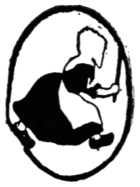
A trade-mark that has achieved great renown.
In the case of Johnson & Johnson v Bauer & Black (82 Fed. R. 662, reversing 79 Fed. R. 954) it was held that the complainant's mark of a red Greek cross, used on plasters, was infringed by the defendant's mark of a Greek cross with a red circle in the center, containing the letters "B & B", and used on the same class of goods.
A trade-mark adopted for a patented article during the life of the patent, is held to be descriptive of the article, and the right to its exclusive use expires at the expiration of the patent.
The import of this far-reaching trade-mark doctrine is illustrated in the celebrated Singer case.
The Singer Manufacturing Company, when the patents on its sewing machine were about to expire, adopted as a trade-mark the word "Singer" blended with a device. The effect of this action, if the validity of the trade-mark had been sustained, would have been to perpetuate the right to the exclusive use of the word "Singer" as applied to sewing machines. In this event, at the expiration of the patents, any person would have had the right to manufacture Singer machines, but only the Singer Manufacturing Company would have had the use of the name "Singer."
It was held by the courts that the right to use the name "Singer", as applied to machines of this particular design, became public property when the patents expired. The court said, in the case of Brill v Singer Mfg. Co. (41 Ohio St.):—
"A patentee or his assignee, by incorporating into his trade-mark the distinctive name by which a patented machine has become known to the public during the existence of the patent, cannot, after the expiration of the patent, take away from the public the right of using such name. The trade-mark cannot be made a guise for extending the monopoly, or preventing the name from becoming, with the patent, the property of the public."
But if the trade-mark is adopted and used before the article is patented, the exclusive right to the trade-mark continues after the patent expires.
In this case the patent is secondary to the trade-mark, and the trade-mark is held not to be descriptive. The word "Gants" was used as a trade-mark on corsets for several[61] years before the article was patented. At the expiration of the patent, another manufacturer began to make corsets of this description, calling them "Gants". On the showing of the plaintiff that the patent was subsequent to the adoption of the trade-mark, the defendant was enjoined from using the name, although there was nothing to prevent him from continuing to make corsets of this description.
An individual has a right to use his own name in business transactions, but he cannot use it in a way that will deceive, directly or by inference, those who buy his goods. He cannot use the likeness of his name to that of another party of the same name for the purpose of trading on the latter's established reputation.
This principle of equity is well illustrated by the legal contentions over the name Baker, used as a trade-mark for chocolate.
For a hundred and thirty-one years the firm of Walter Baker & Co., and its predecessors, have manufactured chocolate at Dorchester, Mass. For more than a generation past, the firm has done business under its present name. "Baker's Cocoa," as the principal product of the firm is popularly called, has achieved great success. This national popularity of the name "Baker" as applied to cocoa and chocolates, began, some years ago, to attract other persons by the name of Baker. One of the Bakers—a William H.—began to manufacture chocolate in Winchester, Va., in 1894, and put it on the market, labeled "W. H. Baker & Co." At that time the products of Walter Baker & Co. were labeled "W. Baker & Co." It can be seen that the substitution of W. H. Baker & Co.'s goods for those of Walter Baker & Co., was an easy matter for any retailer who wanted to do it. The packages were much alike. The retailer made a larger profit on the product of W. H. Baker & Co.
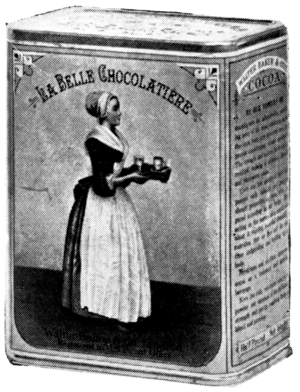
The Walter Baker Package
(Front)
Walter Baker & Co. sued W. H. Baker in the Federal Court in Virginia, and at the same time began a suit against W. H. Baker's New York agent, Sanders, to prevent their use of the name "Baker" or the firm name, "Baker & Co." In the Virginia suit, the opinion of the court was that while W. H. Baker had a right to use the name "Baker," it being his own name, he could not use it in connection with the sale of cocoa or chocolate unless he made a distinction between it and the name of Walter Baker & Co. which would be easily observed by customers. The nature of the required distinction was not specified by this court.
In the suit in the Federal Court for the Southern District of New York against Sanders, the New York agent of W. H. Baker, the court's decision was essentially the same as that of the Federal Court in Virginia. The New York court specified, however, that the defendant should put in conspicuous lettering on his packages these words: "W. H. Baker is distinct from and has no connection with the old chocolate manufactory of Walter Baker & Company."
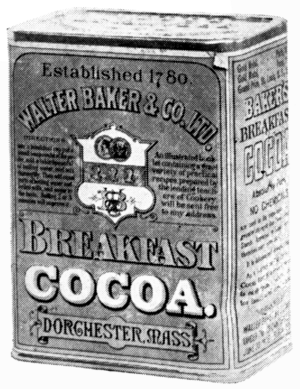
The Walter Baker Package
(Back)
This suit had been settled a year or two, when in New York, another Baker—William P.—began to sell a "Baker's Chocolate." Suit being brought to enjoin him by Walter Baker & Co., it was decided by the court that he must not use the name "Baker" alone, or "W. Baker." He was allowed to use his own name if spelled in full, "William Phillips Baker," or he might use a middle initial—"William P. Baker"—and he was directed to state on his labels that his goods were made and sold by "William P. Baker, of New York."
The contentions of the various Bakers were stilled and the mantle of peace lay upon them for a short space. Then, as the record shows, a William H. Baker, of Syracuse, felt the calling of chocolate manufacturer stir within him.
The William H. Baker of Syracuse imitated the packages and labels of the William H. Baker of Winchester, Va. His evident intention was to make it appear that he was the William H. Baker who had been enjoined by Walter Baker & Co., for he stated conspicuously on his[63] label "W. H. Baker is distinct from and has no connection with the old chocolate manufactory of Walter Baker & Co."
William H. Baker, of Winchester, Va., brought suit against the Syracuse Baker to prevent him from using the former's label. Injunction was granted, but the defendant was permitted to use the name "William H. Baker" if he printed the name "Syracuse" conspicuously in connection with it.
The suit of Royal Baking Powder Co. v Royal (122 Fed. 337—1903; 58 C. C. A. 499-506), deals with the controversy of this well-known baking powder concern over the use of the name "Royal" on baking powder by an individual by the name of "Royal." The court held that Royal could make and sell baking powder under his own name, but to prevent confusion he should not place his name on the front label, and that he should make it inconspicuous.

The package now used by William H. Baker, of Syracuse, Inc.
From a consideration of these cases, and many others where the same issue was involved, the principle may be definitely established that, while courts will not prevent an individual from using his name altogether, they will restrict the manner of its use when there is shown an intention to trade on another's reputation.
It is a settled principle of law that a complainant must appear in a court of equity with clean hands. In other words, an essential misrepresentation of a complainant's goods, by means of his trade-mark, or on his labels, or through advertisements, is a bar against his action for relief from infringement.
One Flavel made and sold a stove under the name "Flavel's Patent Kitchener." The defendant, Harrison, began to make and sell another stove under the same name. Flavel sued to enjoin Harrison, but an injunction was denied when it was shown that Flavel's stove was not patented, although its name would lead one to believe that it was made under a patent.
In another case, the makers of a toilet preparation[64] known as "The Balm of a Thousand Flowers" brought suit to enjoin another party from selling a similar preparation under the name of "The Balm of Ten Thousand Flowers." The complainant's motion to enjoin was denied, when it was shown in court that his "Balm of a Thousand Flowers" did not contain the balm of any flower whatsoever—in fact, was not a balm at all, but a soap—and that its chief ingredients were oil and alcohol. It was held that the trade-mark was deceitful and complainant's motion was denied. Fetridge v Wells (4 A 66 Pr. 144; B. How. Pr. 385).
The infringement of trade-names and trade-marks in most classes of merchandise is relatively infrequent compared with the extensive substitution, infringement and counterfeiting that are continually going on in the liquor, wine, cigar and allied trades.
This had become an evil of such formidable proportions that in 1904 an organization under the title of the Trade-Mark Protective Company was formed to run down and prosecute offenders. The clients of this company are mostly importers and producers of whiskies, wines, olive oils, cordials, cigarettes and cigars. The company has a staff of skilled detectives, who are always at work looking for imitators and counterfeiters of the goods of the company's clients. After securing evidence of an infringement the company undertakes the prosecution of the offenders.
The methods of the Trade-Mark Protective Company in prosecuting infringers and counterfeiters are of the kind that inspire evil-doers with terror as well as respect.
In many cases the bottles, or packages, and labels—including trade-marks—have been counterfeited so perfectly, and in such detail, that expert bottle-makers and lithographers were required as witnesses to show the difference between the spurious and the genuine.
An account of a few of the cases prosecuted by the Trade-Mark Protective Company are given here for the purpose of showing the methods of this class of dealers in spurious goods.
One Young, doing business as the "Cincinnati Distilling Company" was found using counterfeits of the labels of the Wilson Distilling Company. He was tried, convicted, and sentenced to six months in the workhouse and to pay a fine of $300.
A cigar dealer, when asked by customers for the well-known[65] "Romeo and Juliet" cigar, which bears a label reading "Romeo y Julieta", sold an imitation bearing a label on which the words "Romeo, el Amante de Julietta" appeared—the words "Romeo" and "Julietta" being in large type. The cigars bearing this label were seized, and the dealer was restrained from selling any "Romeo and Juliet" cigar which did not bear the genuine label.

Genuine Old Tom Gin

Spurious Old Tom Gin
Reproduced by courtesy of Trade-Mark Protective Company.
On this page are shown pictures of two bottles, each labeled "Old Tom Gin". The bottle with the spurious label, shown on the right, is identical in size and shape with[66] the genuine bottle. The labels are so much alike, in design and coloring, that one would easily pass for the other on casual, careless inspection. Upon obtaining the requisite evidence the spurious stock was seized, and the use of the imitation label was enjoined.
In the case of the owners of Edouard Pernod's Absinthe against John B. Van Opstal and others it was shown that the defendants were selling an imitation of Pernod's Absinthe under the fictitious name of "Aernod's" Absinthe, relying upon the similarity in sound to deceive purchasers. In this case the label of the genuine Pernod was closely imitated in design and color, and second-hand Pernod bottles were used.
The defendants being brought into court, a judgment and injunction was entered against them.
On the next page are two Chartreuse labels. The one on the right, bearing the name "Garnier" is genuine. The labels were exactly the same size and color. The infringing label was so clearly an imitation that the offending party did not contest the case, but surrendered the imitation labels to the Trade-Mark Protective Company, and agreed never to use them again.
Since the expulsion of the Chartreuse monks from France, and their settlement in Spain, they have adopted a new label, but the original label as shown here is also still used by them.
They have established their right to the exclusive use of the name "Chartreuse" in the United States by a suit recently decided by the Supreme Court. Reference to this case has been made on page 35 of this book.
In another case, where an infringement of Fernet Branca Bitters was prosecuted, the defendant claimed that he had a right to use the name, as his partner was named Branca, and that this partner was a skilled worker in the preparation of bitters. He was, nevertheless, restrained from using the Fernet Branca name on his labels.
Most of these prosecutions are based on the law of unfair trade, but in one case, that of Petrotta, accused of selling counterfeit Martell Brandy and other liquors, the complainant founded his case on the charge of larceny. He held that in selling spurious goods for genuine the defendant obtained money under false pretences, and in that respect he is like a person who obtains money on a worthless check. This argument was upheld by the court, and Petrotta was sent to prison for two years.
Labels reproduced by courtesy of Trade-Mark Protective Company.
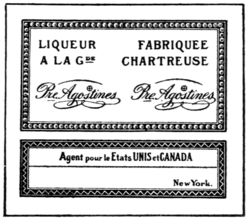
Infringement of Chartreuse Label

Genuine Chartreuse Label
This case is notable, in that it is the first case on record of a conviction for larceny of money obtained on a sale of counterfeit goods.
The refilling of bottles is a specific offence, covered by statutes in some of the states. It is needless to say that it is extremely difficult to obtain evidence of refilling that will convict.
In the case of the People v Luhrs (195 N. Y., 377), in which the defendant Luhrs was charged with having refilled a Wilson Whiskey bottle, he put in the unusual defence that although he refilled a Wilson Whiskey bottle, he refilled it with Wilson Whiskey. But the New York penal code states that it is unlawful to sell any goods which are represented to be the manufacture of any other party than the seller, unless such goods "are contained, in the original packages, and under the labels, marks or names pasted thereon by the manufacturer."
The defendant contended that this law was unconstitutional, because it prevented him from selling his legitimate property in any way he chose to sell it, and thus deprived him of his property without due process of law. The court did not accept this contention, as the defendant obviously had the right to sell Wilson Whiskey any way he might desire, and at any price, on the condition that he did not sell it in a trade-marked package that had contained other goods. The trade-mark certifies both to the manufacture and the packing of contents. By refilling bottles, even with the same kind of goods, the dealer makes a false representation, as the bottle would not contain, after refilling, what was originally put in it.
Manufacturers are protected against infringement by foreigners sending goods bearing infringing trade-marks and labels to the United States by Section 27 of the Act of 1905, which is as follows:
"That no article of imported merchandise which shall copy or simulate the name of any domestic manufacture, or manufacturer or trader, or of any manufacturer or trader located in any foreign country which, by treaty, convention, or law affords similar privileges to citizens of the United States, or which shall copy or simulate a trade-mark registered in accordance with the provisions of this act, or shall bear a name or mark calculated to induce the public to believe that the article is manufactured in the United States, or that it is manufactured in any foreign country or locality other than the country or locality in which it is in fact manufactured, shall be admitted to entry at any custom-house of the United States; and, in order to aid the officers of the customs in enforcing this prohibition, any domestic manufacturer or trader, and any foreign manufacturer or trader, who is entitled under the provisions of a treaty, convention, declaration, or agreement, between the United States and any foreign country to the advantages afforded by law to citizens of the United States in respect to trade-marks and commercial names, may require his name and residence, and the name of the locality in which his goods are manufactured, and a copy of the certificate of registration of his trade-mark, issued in accordance with the provisions of this act, to be recorded in books which shall be kept for this purpose in the Department of the Treasury, under such regulations as the Secretary of the Treasury shall prescribe, and may furnish to the Department facsimiles of his name, the name of the locality in which his goods are manufactured, or of his registered trade-mark; and thereupon the Secretary of the Treasury shall cause one or more copies of the same to be transmitted to each collector or other proper officer of customs."
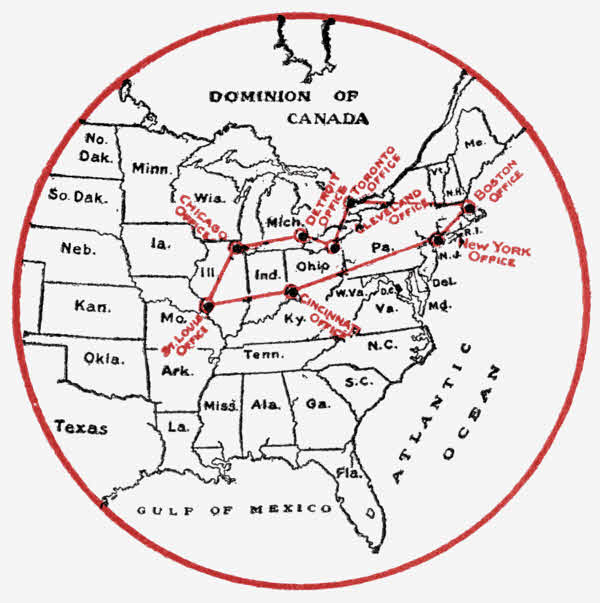
Within This Circle
Eighty-five millions of people live within this circle. It is the great battle-ground on which advertising campaigns are won or lost.
In this area are 42 cities of 100,000 or more inhabitants, and 167 other cities with populations between 25,000 and 100,000.
The J. Walter Thompson Company knows this territory from actual contact with the buying public that lives in it.
Our branch offices in the great mercantile centers, as shown on the map, have been established for the purpose of studying at first hand the conditions of distribution and merchandising that must necessarily figure with great weight in any national advertising campaign. We have better facilities for acquiring practical selling information than any other agency in America.
Most of the national advertisers in the United States and Canada are within thirty minutes of one of our eight offices. Ninety per cent of national advertisers are within two hundred miles of a J. W. T. office.
J. WALTER THOMPSON COMPANY
New York: 44 East 23rd Street
Boston: 201 Devonshire Street
Cincinnati: First National Bank Bldg.
St. Louis: Odd Fellows Bldg.
Chicago: The Rookery
Cleveland: Swetland Bldg.
Detroit: Trussed Concrete Bldg.
Toronto: Lumsden Bldg.
London: 33 Bedford St., Strand
It is a fixed principle of the law that a trade-mark cannot be assigned, or transferred, without a transfer of the business with which it is associated.
Trade-marks indicate origin. They are intimately associated with the merchandise for which they are registered. This being a fundamental principle of trade-mark law, it can be understood that a trade-mark cannot pass from hand to hand, and transferred as a separate thing, without losing its real function as a trade-mark.
The Act of 1905 (Section 10) provides that any registered trade-mark may be assigned "in connection with the good-will of the business in which the mark is used."
In the case of MacMahan Pharmacal Co. v Denver Chemical Mfg. Co. (113 Fed. R. 468), the court said:
"A trade-mark cannot be assigned, or its use licensed, except as incidental to a transfer of the business or property in connection with which it has been used. An assignment or license without such a transfer is totally inconsistent with the theory upon which the value of a trade-mark depends and its appropriation by an individual is permitted. The essential value of a trade-mark is that it identifies to the trade the merchandise upon which it appears as of a certain origin, or as the property of a certain person.... Disassociated from merchandise to which it properly appertains, it lacks the essential characteristics which alone gives it value, and becomes a false and deceitful designation."
There is a silk fabric bearing a "Radium" trade-mark, and known in the trade, and among consumers as "Radium Silk." The manufacturers of this fabric, The Gilbert Manufacturing Company, assigned this trade-mark in 1905 to another concern (Eiseman & Company). With the trade-mark they turned over to Eiseman & Company all the manufactured and labeled goods then in their possession.[70] Thereupon the Gilbert Company ceased to use the trade-mark, but did not stop manufacturing the goods, which they put upon the market under the name "Electra". It seems to have been understood by Eiseman & Company, according to the evidence, that the Gilbert Company was to continue making the goods, provided they gave their product some other name than "Radium". As soon as Eiseman & Company obtained the assignment of the trade-mark they, too, began to manufacture the fabric, and sell it under the "Radium" trade-mark.

A trade-mark, or an advertising character, or a catch phrase, may be so thoroughly advertised that it becomes better known than the commodity to which it applies. A little New York girl, age six, who had hardly passed a day of her young life without seeing a ferocious Durham bull glaring from billboards and the fences of vacant lots, gravely said to her mother one day: "Mamma, is all tobacco made from bulls?"
Now the matter comes into court through the suit of Eiseman & Company to prevent a third manufacturer from using the "Radium" trade-mark. They contended that the assignment of the mark to them by its original owner, The Gilbert Mfg. Co., gave them the exclusive right to its use.
The court held that, in the first place, the assignment of the trade-mark to Eiseman & Company was invalid, because it was not accompanied by a transfer of the good-will; in the second place, the fact that the Gilbert Company discontinued the use of the trade-mark, constituted an abandonment. Injunction was denied.
In this case, the court said: "When a trader has sold some particular article under a selected name to such an extent as to secure registration, he has established a special business in which that trade-mark is used, and if the trade-mark becomes so valuable as to induce him to sell it, he must, as a condition of transfer under the statute, assign that special business with the trade-mark of which it was the parent. Eiseman & Company, therefore, acquired no rights under the alleged assignment, which did not carry the special business."

While this trade-mark is simple, it lacks attractiveness and euphony. It is without distinction, and is easily overlooked and forgotten.
There are exceptions, however, to this rule. The nature of these exceptions may be best shown by citing a case—that of Witthaus v Braun (44 Maryland—1875). In this case a tobacco dealer, who did not manufacture goods[71] himself, had special brands made for him by a manufacturer. The tobacco dealer owned the brands, and merely hired the manufacturer to make his goods. The dealer assigned to the manufacturer "all his smoking tobacco brands", without transferring any other part of his business. It was held that in this case the assignment was valid, because the origin of the goods had not been changed by the transaction. The same manufacturer continued to make the tobacco, the only difference being that he now owned the business, instead of making the goods on contract.
The right to use a trade-mark identified with a business location may pass, under certain circumstances, to a purchaser of the building.
The purchaser of a hotel building, for example, buys with it the right to use its name, unless a specific stipulation to the contrary is made.
A theatre building known as Booth's Theatre was owned and managed by one Booth. After several years of occupancy, he leased the building to another person, who proceeded to give theatrical performances there. In his advertisements he referred to the place as Booth's Theatre, giving his own name as lessee. Thereupon, Booth attempted to enjoin this use of the name. The court held that the name passed with the lease of the building.
In cases where the business is of such a personal nature that the trade-mark or trade-name is identified in the public mind with the work of some particular individual, it is obvious that deception would be practised if the same identifying mark were used after that individual had ceased his connection with the enterprise. In such cases, there can be no valid transfer of the trade-mark even though the entire business, including good-will, is sold. Such a trade-mark is personal. Its use on goods indicates the special knack or skill of some one person.
The courts will protect the purchaser of a business in the use of its trade-mark or trade-name against infringement by the former owner, even though the trade-name is that of the former owner.
This principle is illustrated in the case of Jergens Co. v Woodbury, given in the New York Law Journal (Nov. 1907). The Jergens Company was the sales agent of John[72] H. Woodbury, the celebrated dermatologist, in the sale of "Woodbury's Facial Soap." In 1901 Woodbury assigned the business to the complainant. Under the complainant's management a large and profitable sale for the soap was established.
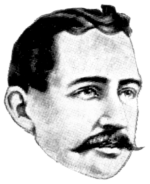
The famous Woodbury trade-mark.
In 1906, Woodbury started to manufacture soap again, calling his product "Woodbury's New Skin Soap." This product, so far as the package or wrappers were concerned, had no resemblance to the complainant's soap, the only point of similarity being in the name.
In a suit brought in the New York Supreme Court it was held by the court that there was ground for belief that the public would be misled by defendant's use of the name Woodbury, and he was accordingly enjoined.
This case went up to the Court of Appeals, and that court upheld the decision of the lower court, in so far as the defendant was restrained from using the name Woodbury in connection with the sale of soap in such a way that the public would be led to believe that his product was "Woodbury's Facial Soap" or a new brand thereof.
For the assignment of a trade-mark no particular form of assignment is required except it must be in writing.
The law provides that assignments may be recorded in the Patent Office. If any assignment is not recorded within three months after its date, it will be held void as against a subsequent purchaser for valuable consideration.
Trade-marks are registered in Canada in the Department of Agriculture.
The Canadian law recognizes two kinds of trade-marks, viz.: General Trade-marks and Specific Trade-marks. These two kinds of marks require separate registrations.
A "general trade-mark" means a trade-mark used in connection with the sale of various articles in which a proprietor deals in his trade, business, occupation or calling generally.
A "specific trade-mark" means a trade-mark used in connection with the sale of a class of merchandise of a particular description.
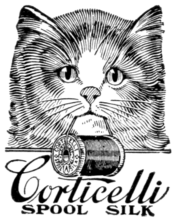
The Corticelli kitten is both a trade-mark and an advertising character.
In this respect the Canadian and American trade-mark laws differ materially. The American law does not recognize a "general" trade-mark—that is, a trade-mark applicable to any merchandise a manufacturer may produce, irrespective of its class. An American trade-mark is registered for use in connection with a specific product, or for use in connection with a class of merchandise, all the units of which have the same general descriptive qualities. The "specific trade-mark" of Canada corresponds closely to the American trade-mark.
The Canadian definition of a trade-mark is as follows:
"All marks, names, labels, brands, packages or other business devices, which are adopted for use by any person in his trade, business, occupation or calling, for the purpose of distinguishing any manufacture, product or article of any[74] description manufactured, produced, compounded, packed or offered for sale by him, applied in any manner whatever either to such manufacture, product or article, or to any package, parcel, case, box or other vessel, or receptacle of any description whatsoever containing the same, shall, for the purposes of this Act, be considered and known as trade-marks."
The Trade-mark Act of Canada is more broad and liberal than the American Act, as is shown by this definition of trade-marks. Not only are marks, names, labels and brands considered trade-marks, but "packages" and "other business devices" are also included.
An applicant who seeks to register a trade-mark must state in his application whether the trade-mark is intended to be general or specific. If specific, a description of the merchandise on which it is to be used must be made a part of the application.
A general trade-mark, once registered, shall "endure without limitation."
The registration of a specific trade-mark expires in twenty-five years, but it may be renewed at the end of that period, and so on from time to time.
The registration fee for a general trade-mark is $30.00; for a specific trade-mark, $25.00.
The Minister of Agriculture may refuse to register a trade-mark for any one of the following reasons:
1st. If he is not satisfied that the applicant is undoubtedly entitled to the exclusive use of such trade-mark.
2nd. If the trade-mark proposed for registration is identical with or resembles a trade-mark already registered.
3rd. If it appears that a trade-mark is calculated to deceive or mislead the public.
4th. If the trade-mark contains any immorality or scandalous figure.
5th. If the so-called trade-mark does not contain the essentials necessary to constitute a trade-mark, properly speaking.
The "essentials necessary to constitute a trade-mark" are not defined by the law, an omission which means that the English common law definition of a valid trade-mark, as shown by the decisions of the courts, must be the basis on which eligibility to registration is based. No mark or[75] symbol which has a designating or descriptive quality may be registered.
When a descriptive word has been registered, through error of the registrar, it does not give the owner of the mark exclusive right to its use. As in the United States, registration is only prima facie evidence of validity.
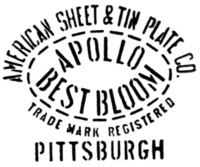
A trade-mark used on sheet tin. It is affixed by stenciling.
The right to a trade-mark belongs to the first user of the mark. If it is registered by any other person than its first user, the registration may be set aside as invalid upon the production of proof of its prior use by any other person than the registrant.
The law states that "no person shall institute any proceeding to prevent the infringement of any trade-mark, unless such trade-mark is registered in pursuance of this act."
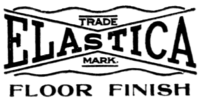
A well-advertised trade-mark.
This provision of the law would seem to exclude actions based on the common law, but in practice the Canadian courts take cognizance of the doctrine of unfair trade. The prime requisite of registration before infringement proceedings can be instituted merely makes the mode of procedure different from that in the United States. The complainant must get his trade-mark registered before he begins his suit against the infringement. If the mark alleged to infringe has already been registered, the plaintiff moves to set the registration aside as invalid, and have his own mark registered instead of it.
A circular containing the full provisions of the Canadian law, with directions and forms for making an application for registration, may be obtained by any person who will write for it to the Minister of Agriculture, Ottawa, Canada.
A Trade-mark may be a word, or words; or a device; or a device combined with a word or words.
It is often considered desirable to register the name of a product as a trade-mark. Consequently, in the case of new products, the selection of a trade-mark often means the selection of a name for the merchandise with which the trade-mark is to be used.

A familiar and excellent example of a coined word used as a trade-mark.
A trade-mark, to be valid, should not have any meaning obviously descriptive of the goods for which it is registered. The word "Crex", to illustrate our meaning, is an arbitrary coined word. As such it is registrable, and besides its undoubted validity, it has some of the best qualities that a trade-mark can possess, in that it is short—of one syllable—easy to pronounce and remember, and its sound is not displeasing to the ear. Note that in the name "Crex Grass Furniture", the word "Crex" is alone registrable. "Grass Furniture" is a descriptive term.
Coined words, like Karo, Onoto, Chiclets, Crisco, Uneeda, Jap-a-lac, Sapolio, are virtually infringement proof. The ownership of a coined word, as applied to the commodity with which it is associated, rests absolutely in the individual or concern that first uses it.
Many of these coined words are only fortuitous combinations of letters, arrived at after divers experiments. Such a word is "Onoto", applied to a fountain pen. It was selected from a list of hundreds of similar names, in which all sorts of curious arrangements of letters were set down.
In the creation of an artificial or "coined" word, a mere misspelling of a word or phrase does not make it registrable, if it would not be so otherwise. "Bestok", a misspelling of[77] "Best Stock", was refused registration, as it is plainly descriptive.
"Omo" is the trade-mark of a dress shield; "Persil"—a coined word—is a washing compound; and "Steero" is the trade-mark and the name of bouillon cubes.
"Sealpackerchief" is a name made up of "Sealed", "Package" and "Handkerchief". It is the trade-name of a brand of handkerchiefs that are sold in clean sealed packages.
"Nabisco" is a name made by joining together the first syllables of the three words "National Biscuit Co."—Na-Bis-Co—Nabisco.
The Porto Rico Seal of Quality
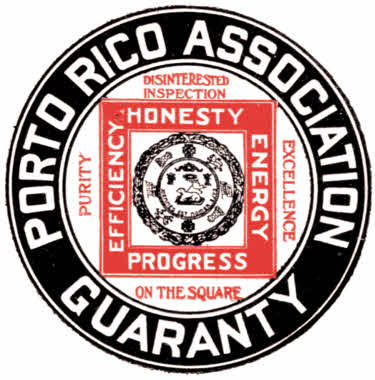
The Government of the Island of Porto Rico has given its encouragement and material support to the formation of an association among the large planters, shippers and manufacturers of the Island. This organization, known as the Porto Rico Association, is active in promoting the sale of Porto Rican products in the United States. As a guaranty of the quality of the goods, each member of the Association—after his shipment has been inspected and approved—has the right to use the "Porto Rico seal of quality", shown here. This seal is not a trade-mark in the technical sense, but it is affixed to Porto Rican merchandise of high quality, sold at the New York store of the Porto Rico Association at 510 Fifth Avenue, New York, and elsewhere, and in that relation it is a common law trade-mark, with ownership vested in the Porto Rico Association.
The name "Roxonia", a registered trade-mark, applied to hosiery and underwear, is an evolution of the name Roxburghe. When the goods were first put on the market the[78] Duke of Roxburghe was on a visit to the United States, "taking notice" of an heiress, and was, in virtue of this situation, much in the public prints. A manufacturer of underwear thought Roxburghe sounded pretty good, and he applied for registration of the name as a trade-mark. His application was refused on the ground that Roxburghe was the name of a person. Abandoning "Roxburghe", another cogitation of the subject brought to light the word "Saxonia", this name having been suggested by the fact that Saxony is one of the great centers of hosiery production. "Saxonia" was refused registration because it is a geographical term. The addition of two letters to the word "Saxon" does not make sufficient change to remove it from the prohibited class of geographical terms. With these two rejections before him, it occurred to the manufacturer that he could unite the two words, and get rid of the objectionable feature of each. This was done, and the result is "Roxonia", which is not only a valid trade-mark, but a very good one.

The clever trade-mark of a cleaning fluid.
A trade-mark may consist of a coined word which is suggestive, but not descriptive. An example of this is shown in the "Arco Spotzoff" trade-mark. This is the name, as well as the trade-mark, of a cleaning fluid. "Spots Off", spelled in any way whatsoever, suggests cleaning and cleanliness, but it does not describe the cleaning fluid. This is a very ingenious trade-mark. With a slight variation it would be unregistrable. For instance, "Spot Remover" would not be valid, because it is an ordinary descriptive term—an advertisement, in short.

Susceptible of mispronunciation.
Two other examples of coined words, suggestive but not descriptive, are "Sealpackerchief"—mentioned above—and "Hydegrade".
In some instances, there is a sort of tangential, or left-handed suggestiveness, about a trade-mark which gives it a significance quite different from the idea that was in its owner's mind when he adopted it. This is a defect in any trade-mark. An example of this is the "Ruberoid" trade-mark, applied to a high-quality, ready-to-lay roofing, sold in rolls. It is pronounced "Rue-ber-oid". The owners of this product state, in their advertising, that[79] Ruberoid does not contain any rubber. It is not a rubber roofing. But a large percentage of the public pronounces the word "Rubber-oid", and many people have the impression that Ruberoid is a rubber roofing. The name is suggestive of rubber. This effect is not an intentional one, as is plainly shown by the widely advertised statement of the owners that Ruberoid contains no rubber, as well as by their taking the trouble to indicate the correct pronounciation in their advertisements.
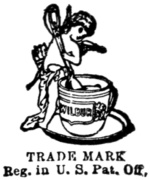
The trade-mark of H. O. Wilbur & Sons.
A trade-mark name should not be easily susceptible of mispronunciation.
An arbitrary symbol may be a valid trade-mark. The Wilbur Chocolate trade-mark, showing a Cupid stirring a cup with a large spoon, is an example of an arbitrary symbol used for this purpose.
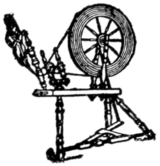
The McCutcheon trade-mark. Suggestive of fine linen.
The McCutcheon trade-mark, consisting of the representation of an old-fashioned spinning wheel, is arbitrary in the sense of not being descriptive, but it is suggestive of flax and fine linen, which is a specialty of the McCutcheon store.
The trade-mark of Domino sugar is the picture of a red domino or mask.
Initials, like "E. & W."—used on Earl & Wilson collars; "G.E."—the trade-mark of the General Electric Company; and "R & G"—used on corsets, are valid as trade-marks.

A trade-mark in which the defects predominate.
A trade-mark may be the name of a fictitious person, like "Buster Brown", used in connection with hosiery, and "Dorothy Dodd" used as a trade-mark for shoes.
A famous example of initials used for this purpose is the "B.V.D." trade-mark.

An excellent, distinctive trade-mark.
Good trade-marks are simple and distinctive. The mark should be of such a character that it can be easily retained in the purchaser's memory, and it is apparent that this is not readily done when it is complicated and commonplace.
Look at the "Sonor" trade-mark, reproduced on this page, as an illustration[80] of this point. The lettering is so involved that it is difficult to read, and it looks like a pattern of some intricate fancy work. Compare it with the simple, clear-cut "Rub-dry" trade-mark.
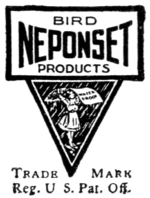
A trade-mark cluttered up with too much detail.
The "Neponset" trade-mark has so much in it, including the picture of a child in a rainstorm, that it loses its character when it is reduced to any practical, small size for advertising purposes. The single word "Neponset", enclosed in a simple design, would be much more effective—or the child holding the piece of roofing over her head would be equally effective, if shown alone, without a background.
An example of a commonplace trade-mark is the big "P" surrounded by a circle. This mark lacks distinction and originality. It makes but little impression upon a reader's mind, and is soon forgotten.
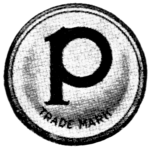
A trade-mark that bears a startling resemblance to a soda-water check.
Compare the big "P" with the admirable "Pacific" Mills trade-mark. The Pacific Mills emblem is graceful, simple, distinctive, and has a swing and a whirl to it that suggest motion. When a symbol is used as a trade-mark it is always advisable to put the suggestion of motion into it, if this can be done without the sacrifice of some other essential quality. A thing in motion arrests the eye, and holds the attention, much better than a still figure. Evidence of this is seen in the well-known Dutch Cleanser trade-mark, where the motion of the lady in wooden shoes dominates every other quality of the symbol.
An arbitrary number may be a valid trade-mark. The number "830" has been judicially held to be a good trade-mark for a brand of hosiery. The number "4711"—an arbitrary arrangement of figures—has been in use since 1792 as a trade-mark for toilet preparations. The numerals "1" to "35" are valid trade-marks, as applied to Humphrey's Homeopathic Remedies.
A numeral indicating quality or composition cannot be protected against infringement.

This design is very attractive. A fine example of a symbol with wording.
A trade-mark may be the name of a mythological character,[81] like Juno, Venus—there is a Venus lead pencil—Hercules, or Apollo, this last name being used in connection with a player-piano. It may be the name of an historical character, like Voltaire, Buckingham, Mazarin, Napoleon—used with a brand of flour—or Champlain; or Samson, used as a name of a clothes-line sold in a package. It may be the name of a character in fiction, like Hamlet, David Copperfield, Hypatia or Portia. "Pequot", the name of an extinct Indian tribe, is the trade-marked name of a brand of sheets and pillow cases. The name of an existing Indian tribe is not valid as a trade-mark, as it has a geographical significance.
A phrase in common use may be registered as a trade-mark, provided it has none of the qualities prohibited by the Act of 1905. For example, "Yours Truly" is the registered trade-mark of an article of food.
A word in common use may be valid as a trade-mark if it has no defects under the act. There is, for instance, an "Arrow" collar, a "Lion" collar, and a "Velvet" smoking tobacco. If careful consideration is given to the selection, it is sometimes possible to find an ordinary word that may be very effective as a trade-mark. There is, for example, the word "Rainbow", used as a name for dyes. This word is not descriptive of the dyes, but it is tremendously suggestive of their quality and their wide range of colors.
"Gold Cross" is the trade-mark of a brand of condensed milk.
"Skidoo" is the particularly happy name of a rough-and-ready soap, and this is also used as the trade-mark of a marine engine. "Flash" is the name of a soap. "Bread Winner" is the trade-name of a line of children's suits.
There are many trade-marks made up of two or more words, such as "Bachelor's Friend", for hosiery; "Iron-Clad", also a hosiery trade-mark, and "Porosknit"—a coined word made up of "Porous" and "Knit".
The portrait and name of a living person may be registered as a trade-mark, provided the application is accompanied by the written permission of the person whose name and[82] portrait are shown. There is a "Maxine Elliott Soap", and a "Mrs. Rorer's Coffee".
The name of a natural object used in a fanciful sense, may be registered. There are many examples of this usage, such as "Beech-Nut" bacon, "Ivy" corset, "Hawkeye" camera, and "Eagle" condensed milk.
A trade-mark may consist of a fanciful combination of words, like "Blue Jay", applied to corn plasters; "Red Devil", "Silver Moon", and "Flying Cat".
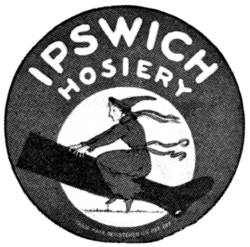
A well-balanced and handsome design.
When a design and wording are used in combination, care should be taken to make them fit together without discord. Attractiveness is a quality that is desirable in a trade-mark if it can be attained without a sacrifice of more virile features. The Ipswich Hosiery trade-mark is eye-catching and attractive. It contains as much in lettering and in illustration as the Neponset trade-mark shown on page 80, and it is much more attractive. This trade-mark—as shown in the accompanying engraving—is descriptive, as it contains the word "hosiery", and it contains a geographical term—"Ipswich". These features would probably prevent its registration under the general Act of 1905, but not under the ten years' clause of that act, provided it could fulfil the requirements of that clause.
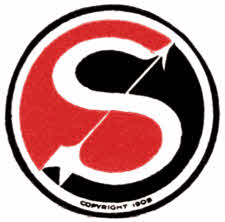
Swift & Co.'s trade-mark.
The trade-mark of Swift & Company, of Chicago, is unusually distinctive. Its symbolism is interpreted in a circular issued by Swift & Company, of which the following is an excerpt:
"Four factors intimately combined enter into the symbol. They are: (1) the 'S', (2) the dart, (3) the circle, (4) the pivot.
"The 'S', combined with the dart in one piece, is a personality symbol, serving to set forth the name 'Swift', both accurately and generally, since the dart is an ancient and world-wide symbol of swiftness.
"The dart by itself is a humanity symbol, carrying the thought of speed and directness. In its position in the symbol it indicates high aim and rectitude.
"The circle is a humanity symbol, carrying the thought of universality, and everywhere recognized as the perfect form.
"The pivot symbol is beautifully developed by the 'S' which centers in the circle, and is itself a form of the pivot symbol.
"The black and red color scheme accentuates the pivot and gives the thought of day and night, of life and death, of heaven and hell—in short, the thought of dualism in life."
This design is simple, graceful, distinctive, and appropriate. In a business as far-reaching and as complex as that of Swift & Company, the quality of adaptability in a trade-mark is highly desirable. This trade-mark is of such a character that it may be used with appropriateness upon merchandise, stationery, packages, boxes, sides of cars, and in advertisements.
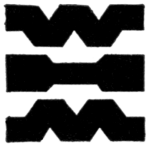
No. 1.
The engravings Nos. 1, 2, 3, and 4, illustrate the various steps taken in devising the trade-mark of the W. H. McElwain Company, of Boston. The fundamental idea was to incorporate the initials of the firm, W. H. M., into the design in some effective way. From a large number of suggestions the design marked No. 1 was selected. It can be seen that the three bars shown in No. 1 make the initials W. H. M.—but somebody has to tell you before you see it.
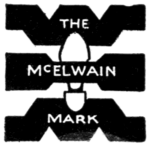
No. 2.
The next step, shown in No. 2, was to put in the sole of a shoe, as the trade-mark is intended for shoes, and to letter "The McElwain Mark" across the face of the bars.
The design shown in No. 2 lacks cohesion and finish. To hold it together, a border was put around it and a Ben Day background thrown in. This produced the figure shown in No. 3.
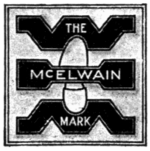
No. 3.
The design marked No. 3 is quite striking, but if you look at it awhile you begin to see defects in it. The black initial bars are too strong and glaring. They push the rest of the design out of the picture. This defect was cured by putting the initial bars in white with the sole of the shoe in black,[84] and making the background darker. By doing this, the proper balance between white and black was obtained.
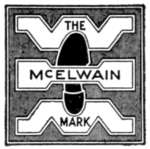
No. 4.
The design shown in No. 4 is the finished trade-mark.
In devising a trade-mark, any one who does not clearly keep the requirements of the law in mind is likely to fall into one or another of three classes of errors.
First, there is a natural tendency to make a trade-mark descriptive, to insert in the wording some phrase like "Best Quality", "Sold the World Over", or "Fits the Figure" or "Good for Children"—all of which are descriptive phrases. You cannot register or protect an advertisement used as a trade-mark, and such phrases are advertisements. A trade-mark is a thing to be advertised. It must not be an advertisement itself.
Second, there is a tendency on the part of many advertisers to incorporate their own names into their trade-marks. This often leads to interminable and costly litigation.
Third, there is a tendency among manufacturers to select geographical terms as their trade-marks, to use the name of the towns or cities where their plants are located, or the names of states, or of rivers or oceans. The trade-name, "Baltimore" hosiery, has a good sound, and the word "Baltimore" is easily remembered, simple and euphonious. But if you are a hosiery manufacturer, and adopt it, you do so at your peril, even if you do business in Baltimore. You cannot protect it against any other manufacturer of hosiery who has a plant in Baltimore, even on the grounds of unfair competition, unless you have used the name exclusively, and for such a long period of time, that it has lost most of its geographical sense in the hosiery trade, and has developed into a word of restricted meaning in that line of business.
P.S. A manufacturer who intends to apply for the registration of a new trade-mark should[85] take the precaution to have the files of the Patent Office searched to ascertain if a trade-mark like his, or similar to it, has been already registered for the same class of merchandise. This should be done before application for registration is made.
When application to register a trade-mark is filed, the trade-mark must be already in use. This use may be limited to affixation upon a small consignment of goods, but it must be a genuine and actual use of the trade-mark.
This being so, it is worth while to ascertain if the proposed trade-mark has already been registered. There are 39,000 registered trade-marks in existence, divided among forty-nine classes of merchandise. Thousands of trade-marks have been registered for some classes. It is not unusual for an applicant to find that the trade-mark he has intended to use has been adopted by someone else.
[1] "The verification required by this section may be made before any person within the United States authorized by law to administer oaths, or when the applicant resides in a foreign country, before any minister, chargé d'affaires, consul, or commercial agent holding commission under the government of the United States, or before any notary public, judge, or magistrate having an official seal and authorized to administer oaths in the foreign country in which the applicant may be, whose authority shall be proved by a certificate of a diplomatic or consular officer of the United States."—(Extract from Section 2, Act of 1905.)
[2] The name Yale, or any similar name, can be registered as a trade-mark only when the applicant can take advantage of the ten years' clause. The word "Yale" as applied to hosiery has been refused registration on the ground that it is a geographical term.
Many illustrations contain text, which is included in the img alt attribute for these illustrations. Text that appears on different lines in an illustration is separated by commas in an alt attribute.
Footnotes have been moved to the end of the text and relabeled consecutively through the document.
Illustrations and sidebars have been moved to paragraph breaks near where they are mentioned.
Punctuation has been made consistent.
Variations in spelling and hyphenation were retained as they appear in the original publication.
The wording of the chapter section titles in the Table of Contents differs from the actual section titles in many cases.
There is no Chapter I section title corresponding to the Table of Contents entry "Ten-Years Clause."
p. 29: The "ORMROD" is not completely legible in the original publication and may not be exactly correct in the alt attribute for this illustration. (ORMROD LEHIGH CO)
p. 68: The Chapter IV section title "Infringement by Foreigners Through Importation" is not included in the Table of Contents.
p. 82: The 3 in 1903 in the "Swift & Co.'s trade-mark" figure on this page is not completely legible in the original publication and may not be correct in the alt attribute for this illustration. (COPYRIGHT 1903)
End of the Project Gutenberg EBook of Things to Know About Trade-Marks, by
J. Walter Thompson
*** END OF THIS PROJECT GUTENBERG EBOOK THINGS TO KNOW ABOUT TRADE-MARKS ***
***** This file should be named 49016-h.htm or 49016-h.zip *****
This and all associated files of various formats will be found in:
http://www.gutenberg.org/4/9/0/1/49016/
Produced by Chris Curnow, Craig Kirkwood, and the Online
Distributed Proofreading Team at http://www.pgdp.net (This
file was produced from images generously made available
by The Internet Archive.)
Updated editions will replace the previous one--the old editions will
be renamed.
Creating the works from print editions not protected by U.S. copyright
law means that no one owns a United States copyright in these works,
so the Foundation (and you!) can copy and distribute it in the United
States without permission and without paying copyright
royalties. Special rules, set forth in the General Terms of Use part
of this license, apply to copying and distributing Project
Gutenberg-tm electronic works to protect the PROJECT GUTENBERG-tm
concept and trademark. Project Gutenberg is a registered trademark,
and may not be used if you charge for the eBooks, unless you receive
specific permission. If you do not charge anything for copies of this
eBook, complying with the rules is very easy. You may use this eBook
for nearly any purpose such as creation of derivative works, reports,
performances and research. They may be modified and printed and given
away--you may do practically ANYTHING in the United States with eBooks
not protected by U.S. copyright law. Redistribution is subject to the
trademark license, especially commercial redistribution.
START: FULL LICENSE
THE FULL PROJECT GUTENBERG LICENSE
PLEASE READ THIS BEFORE YOU DISTRIBUTE OR USE THIS WORK
To protect the Project Gutenberg-tm mission of promoting the free
distribution of electronic works, by using or distributing this work
(or any other work associated in any way with the phrase "Project
Gutenberg"), you agree to comply with all the terms of the Full
Project Gutenberg-tm License available with this file or online at
www.gutenberg.org/license.
Section 1. General Terms of Use and Redistributing Project
Gutenberg-tm electronic works
1.A. By reading or using any part of this Project Gutenberg-tm
electronic work, you indicate that you have read, understand, agree to
and accept all the terms of this license and intellectual property
(trademark/copyright) agreement. If you do not agree to abide by all
the terms of this agreement, you must cease using and return or
destroy all copies of Project Gutenberg-tm electronic works in your
possession. If you paid a fee for obtaining a copy of or access to a
Project Gutenberg-tm electronic work and you do not agree to be bound
by the terms of this agreement, you may obtain a refund from the
person or entity to whom you paid the fee as set forth in paragraph
1.E.8.
1.B. "Project Gutenberg" is a registered trademark. It may only be
used on or associated in any way with an electronic work by people who
agree to be bound by the terms of this agreement. There are a few
things that you can do with most Project Gutenberg-tm electronic works
even without complying with the full terms of this agreement. See
paragraph 1.C below. There are a lot of things you can do with Project
Gutenberg-tm electronic works if you follow the terms of this
agreement and help preserve free future access to Project Gutenberg-tm
electronic works. See paragraph 1.E below.
1.C. The Project Gutenberg Literary Archive Foundation ("the
Foundation" or PGLAF), owns a compilation copyright in the collection
of Project Gutenberg-tm electronic works. Nearly all the individual
works in the collection are in the public domain in the United
States. If an individual work is unprotected by copyright law in the
United States and you are located in the United States, we do not
claim a right to prevent you from copying, distributing, performing,
displaying or creating derivative works based on the work as long as
all references to Project Gutenberg are removed. Of course, we hope
that you will support the Project Gutenberg-tm mission of promoting
free access to electronic works by freely sharing Project Gutenberg-tm
works in compliance with the terms of this agreement for keeping the
Project Gutenberg-tm name associated with the work. You can easily
comply with the terms of this agreement by keeping this work in the
same format with its attached full Project Gutenberg-tm License when
you share it without charge with others.
1.D. The copyright laws of the place where you are located also govern
what you can do with this work. Copyright laws in most countries are
in a constant state of change. If you are outside the United States,
check the laws of your country in addition to the terms of this
agreement before downloading, copying, displaying, performing,
distributing or creating derivative works based on this work or any
other Project Gutenberg-tm work. The Foundation makes no
representations concerning the copyright status of any work in any
country outside the United States.
1.E. Unless you have removed all references to Project Gutenberg:
1.E.1. The following sentence, with active links to, or other
immediate access to, the full Project Gutenberg-tm License must appear
prominently whenever any copy of a Project Gutenberg-tm work (any work
on which the phrase "Project Gutenberg" appears, or with which the
phrase "Project Gutenberg" is associated) is accessed, displayed,
performed, viewed, copied or distributed:
This eBook is for the use of anyone anywhere in the United States and
most other parts of the world at no cost and with almost no
restrictions whatsoever. You may copy it, give it away or re-use it
under the terms of the Project Gutenberg License included with this
eBook or online at www.gutenberg.org. If you are not located in the
United States, you'll have to check the laws of the country where you
are located before using this ebook.
1.E.2. If an individual Project Gutenberg-tm electronic work is
derived from texts not protected by U.S. copyright law (does not
contain a notice indicating that it is posted with permission of the
copyright holder), the work can be copied and distributed to anyone in
the United States without paying any fees or charges. If you are
redistributing or providing access to a work with the phrase "Project
Gutenberg" associated with or appearing on the work, you must comply
either with the requirements of paragraphs 1.E.1 through 1.E.7 or
obtain permission for the use of the work and the Project Gutenberg-tm
trademark as set forth in paragraphs 1.E.8 or 1.E.9.
1.E.3. If an individual Project Gutenberg-tm electronic work is posted
with the permission of the copyright holder, your use and distribution
must comply with both paragraphs 1.E.1 through 1.E.7 and any
additional terms imposed by the copyright holder. Additional terms
will be linked to the Project Gutenberg-tm License for all works
posted with the permission of the copyright holder found at the
beginning of this work.
1.E.4. Do not unlink or detach or remove the full Project Gutenberg-tm
License terms from this work, or any files containing a part of this
work or any other work associated with Project Gutenberg-tm.
1.E.5. Do not copy, display, perform, distribute or redistribute this
electronic work, or any part of this electronic work, without
prominently displaying the sentence set forth in paragraph 1.E.1 with
active links or immediate access to the full terms of the Project
Gutenberg-tm License.
1.E.6. You may convert to and distribute this work in any binary,
compressed, marked up, nonproprietary or proprietary form, including
any word processing or hypertext form. However, if you provide access
to or distribute copies of a Project Gutenberg-tm work in a format
other than "Plain Vanilla ASCII" or other format used in the official
version posted on the official Project Gutenberg-tm web site
(www.gutenberg.org), you must, at no additional cost, fee or expense
to the user, provide a copy, a means of exporting a copy, or a means
of obtaining a copy upon request, of the work in its original "Plain
Vanilla ASCII" or other form. Any alternate format must include the
full Project Gutenberg-tm License as specified in paragraph 1.E.1.
1.E.7. Do not charge a fee for access to, viewing, displaying,
performing, copying or distributing any Project Gutenberg-tm works
unless you comply with paragraph 1.E.8 or 1.E.9.
1.E.8. You may charge a reasonable fee for copies of or providing
access to or distributing Project Gutenberg-tm electronic works
provided that
* You pay a royalty fee of 20% of the gross profits you derive from
the use of Project Gutenberg-tm works calculated using the method
you already use to calculate your applicable taxes. The fee is owed
to the owner of the Project Gutenberg-tm trademark, but he has
agreed to donate royalties under this paragraph to the Project
Gutenberg Literary Archive Foundation. Royalty payments must be paid
within 60 days following each date on which you prepare (or are
legally required to prepare) your periodic tax returns. Royalty
payments should be clearly marked as such and sent to the Project
Gutenberg Literary Archive Foundation at the address specified in
Section 4, "Information about donations to the Project Gutenberg
Literary Archive Foundation."
* You provide a full refund of any money paid by a user who notifies
you in writing (or by e-mail) within 30 days of receipt that s/he
does not agree to the terms of the full Project Gutenberg-tm
License. You must require such a user to return or destroy all
copies of the works possessed in a physical medium and discontinue
all use of and all access to other copies of Project Gutenberg-tm
works.
* You provide, in accordance with paragraph 1.F.3, a full refund of
any money paid for a work or a replacement copy, if a defect in the
electronic work is discovered and reported to you within 90 days of
receipt of the work.
* You comply with all other terms of this agreement for free
distribution of Project Gutenberg-tm works.
1.E.9. If you wish to charge a fee or distribute a Project
Gutenberg-tm electronic work or group of works on different terms than
are set forth in this agreement, you must obtain permission in writing
from both the Project Gutenberg Literary Archive Foundation and The
Project Gutenberg Trademark LLC, the owner of the Project Gutenberg-tm
trademark. Contact the Foundation as set forth in Section 3 below.
1.F.
1.F.1. Project Gutenberg volunteers and employees expend considerable
effort to identify, do copyright research on, transcribe and proofread
works not protected by U.S. copyright law in creating the Project
Gutenberg-tm collection. Despite these efforts, Project Gutenberg-tm
electronic works, and the medium on which they may be stored, may
contain "Defects," such as, but not limited to, incomplete, inaccurate
or corrupt data, transcription errors, a copyright or other
intellectual property infringement, a defective or damaged disk or
other medium, a computer virus, or computer codes that damage or
cannot be read by your equipment.
1.F.2. LIMITED WARRANTY, DISCLAIMER OF DAMAGES - Except for the "Right
of Replacement or Refund" described in paragraph 1.F.3, the Project
Gutenberg Literary Archive Foundation, the owner of the Project
Gutenberg-tm trademark, and any other party distributing a Project
Gutenberg-tm electronic work under this agreement, disclaim all
liability to you for damages, costs and expenses, including legal
fees. YOU AGREE THAT YOU HAVE NO REMEDIES FOR NEGLIGENCE, STRICT
LIABILITY, BREACH OF WARRANTY OR BREACH OF CONTRACT EXCEPT THOSE
PROVIDED IN PARAGRAPH 1.F.3. YOU AGREE THAT THE FOUNDATION, THE
TRADEMARK OWNER, AND ANY DISTRIBUTOR UNDER THIS AGREEMENT WILL NOT BE
LIABLE TO YOU FOR ACTUAL, DIRECT, INDIRECT, CONSEQUENTIAL, PUNITIVE OR
INCIDENTAL DAMAGES EVEN IF YOU GIVE NOTICE OF THE POSSIBILITY OF SUCH
DAMAGE.
1.F.3. LIMITED RIGHT OF REPLACEMENT OR REFUND - If you discover a
defect in this electronic work within 90 days of receiving it, you can
receive a refund of the money (if any) you paid for it by sending a
written explanation to the person you received the work from. If you
received the work on a physical medium, you must return the medium
with your written explanation. The person or entity that provided you
with the defective work may elect to provide a replacement copy in
lieu of a refund. If you received the work electronically, the person
or entity providing it to you may choose to give you a second
opportunity to receive the work electronically in lieu of a refund. If
the second copy is also defective, you may demand a refund in writing
without further opportunities to fix the problem.
1.F.4. Except for the limited right of replacement or refund set forth
in paragraph 1.F.3, this work is provided to you 'AS-IS', WITH NO
OTHER WARRANTIES OF ANY KIND, EXPRESS OR IMPLIED, INCLUDING BUT NOT
LIMITED TO WARRANTIES OF MERCHANTABILITY OR FITNESS FOR ANY PURPOSE.
1.F.5. Some states do not allow disclaimers of certain implied
warranties or the exclusion or limitation of certain types of
damages. If any disclaimer or limitation set forth in this agreement
violates the law of the state applicable to this agreement, the
agreement shall be interpreted to make the maximum disclaimer or
limitation permitted by the applicable state law. The invalidity or
unenforceability of any provision of this agreement shall not void the
remaining provisions.
1.F.6. INDEMNITY - You agree to indemnify and hold the Foundation, the
trademark owner, any agent or employee of the Foundation, anyone
providing copies of Project Gutenberg-tm electronic works in
accordance with this agreement, and any volunteers associated with the
production, promotion and distribution of Project Gutenberg-tm
electronic works, harmless from all liability, costs and expenses,
including legal fees, that arise directly or indirectly from any of
the following which you do or cause to occur: (a) distribution of this
or any Project Gutenberg-tm work, (b) alteration, modification, or
additions or deletions to any Project Gutenberg-tm work, and (c) any
Defect you cause.
Section 2. Information about the Mission of Project Gutenberg-tm
Project Gutenberg-tm is synonymous with the free distribution of
electronic works in formats readable by the widest variety of
computers including obsolete, old, middle-aged and new computers. It
exists because of the efforts of hundreds of volunteers and donations
from people in all walks of life.
Volunteers and financial support to provide volunteers with the
assistance they need are critical to reaching Project Gutenberg-tm's
goals and ensuring that the Project Gutenberg-tm collection will
remain freely available for generations to come. In 2001, the Project
Gutenberg Literary Archive Foundation was created to provide a secure
and permanent future for Project Gutenberg-tm and future
generations. To learn more about the Project Gutenberg Literary
Archive Foundation and how your efforts and donations can help, see
Sections 3 and 4 and the Foundation information page at
www.gutenberg.org
Section 3. Information about the Project Gutenberg Literary Archive Foundation
The Project Gutenberg Literary Archive Foundation is a non profit
501(c)(3) educational corporation organized under the laws of the
state of Mississippi and granted tax exempt status by the Internal
Revenue Service. The Foundation's EIN or federal tax identification
number is 64-6221541. Contributions to the Project Gutenberg Literary
Archive Foundation are tax deductible to the full extent permitted by
U.S. federal laws and your state's laws.
The Foundation's principal office is in Fairbanks, Alaska, with the
mailing address: PO Box 750175, Fairbanks, AK 99775, but its
volunteers and employees are scattered throughout numerous
locations. Its business office is located at 809 North 1500 West, Salt
Lake City, UT 84116, (801) 596-1887. Email contact links and up to
date contact information can be found at the Foundation's web site and
official page at www.gutenberg.org/contact
For additional contact information:
Dr. Gregory B. Newby
Chief Executive and Director
gbnewby@pglaf.org
Section 4. Information about Donations to the Project Gutenberg
Literary Archive Foundation
Project Gutenberg-tm depends upon and cannot survive without wide
spread public support and donations to carry out its mission of
increasing the number of public domain and licensed works that can be
freely distributed in machine readable form accessible by the widest
array of equipment including outdated equipment. Many small donations
($1 to $5,000) are particularly important to maintaining tax exempt
status with the IRS.
The Foundation is committed to complying with the laws regulating
charities and charitable donations in all 50 states of the United
States. Compliance requirements are not uniform and it takes a
considerable effort, much paperwork and many fees to meet and keep up
with these requirements. We do not solicit donations in locations
where we have not received written confirmation of compliance. To SEND
DONATIONS or determine the status of compliance for any particular
state visit www.gutenberg.org/donate
While we cannot and do not solicit contributions from states where we
have not met the solicitation requirements, we know of no prohibition
against accepting unsolicited donations from donors in such states who
approach us with offers to donate.
International donations are gratefully accepted, but we cannot make
any statements concerning tax treatment of donations received from
outside the United States. U.S. laws alone swamp our small staff.
Please check the Project Gutenberg Web pages for current donation
methods and addresses. Donations are accepted in a number of other
ways including checks, online payments and credit card donations. To
donate, please visit: www.gutenberg.org/donate
Section 5. General Information About Project Gutenberg-tm electronic works.
Professor Michael S. Hart was the originator of the Project
Gutenberg-tm concept of a library of electronic works that could be
freely shared with anyone. For forty years, he produced and
distributed Project Gutenberg-tm eBooks with only a loose network of
volunteer support.
Project Gutenberg-tm eBooks are often created from several printed
editions, all of which are confirmed as not protected by copyright in
the U.S. unless a copyright notice is included. Thus, we do not
necessarily keep eBooks in compliance with any particular paper
edition.
Most people start at our Web site which has the main PG search
facility: www.gutenberg.org
This Web site includes information about Project Gutenberg-tm,
including how to make donations to the Project Gutenberg Literary
Archive Foundation, how to help produce our new eBooks, and how to
subscribe to our email newsletter to hear about new eBooks.